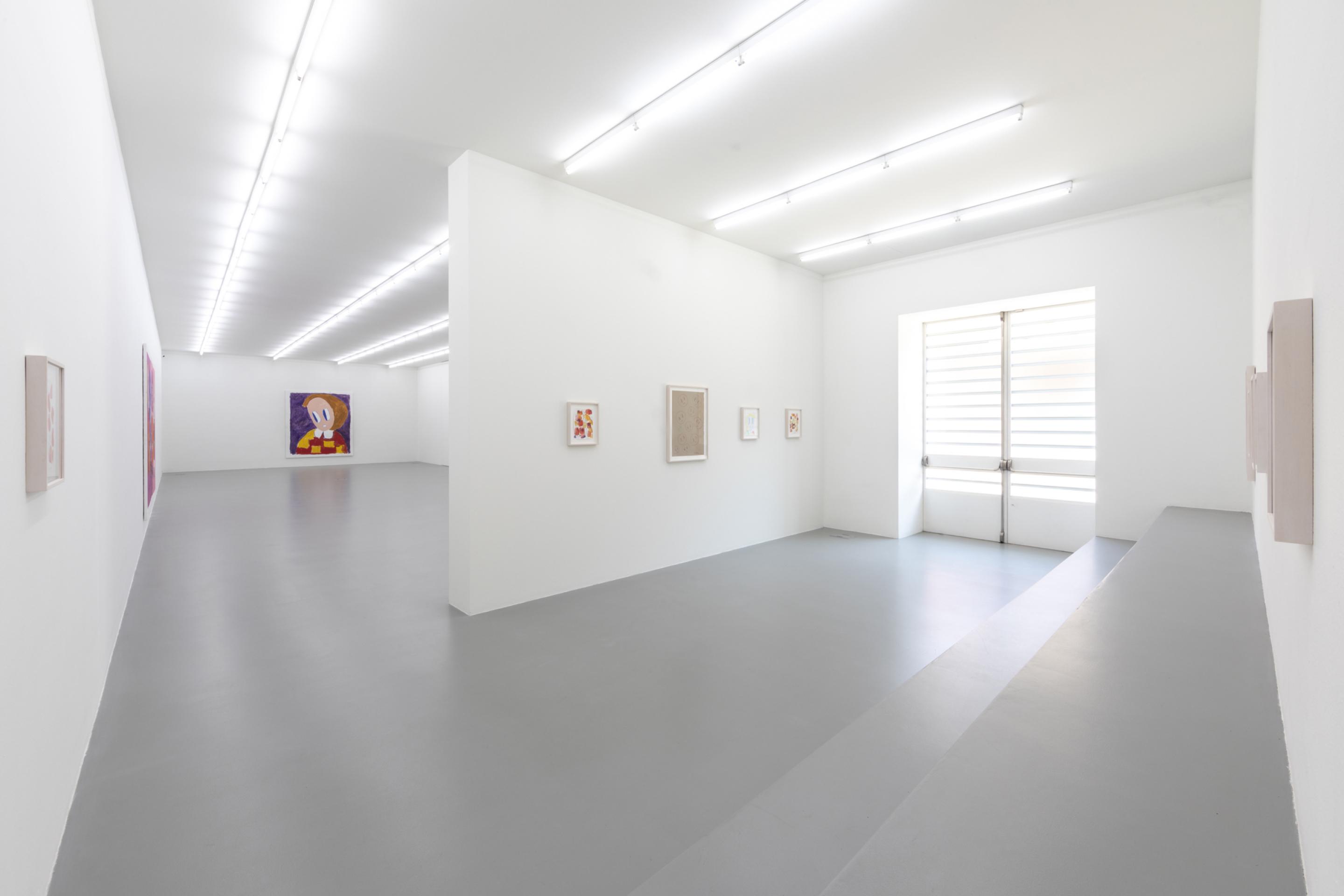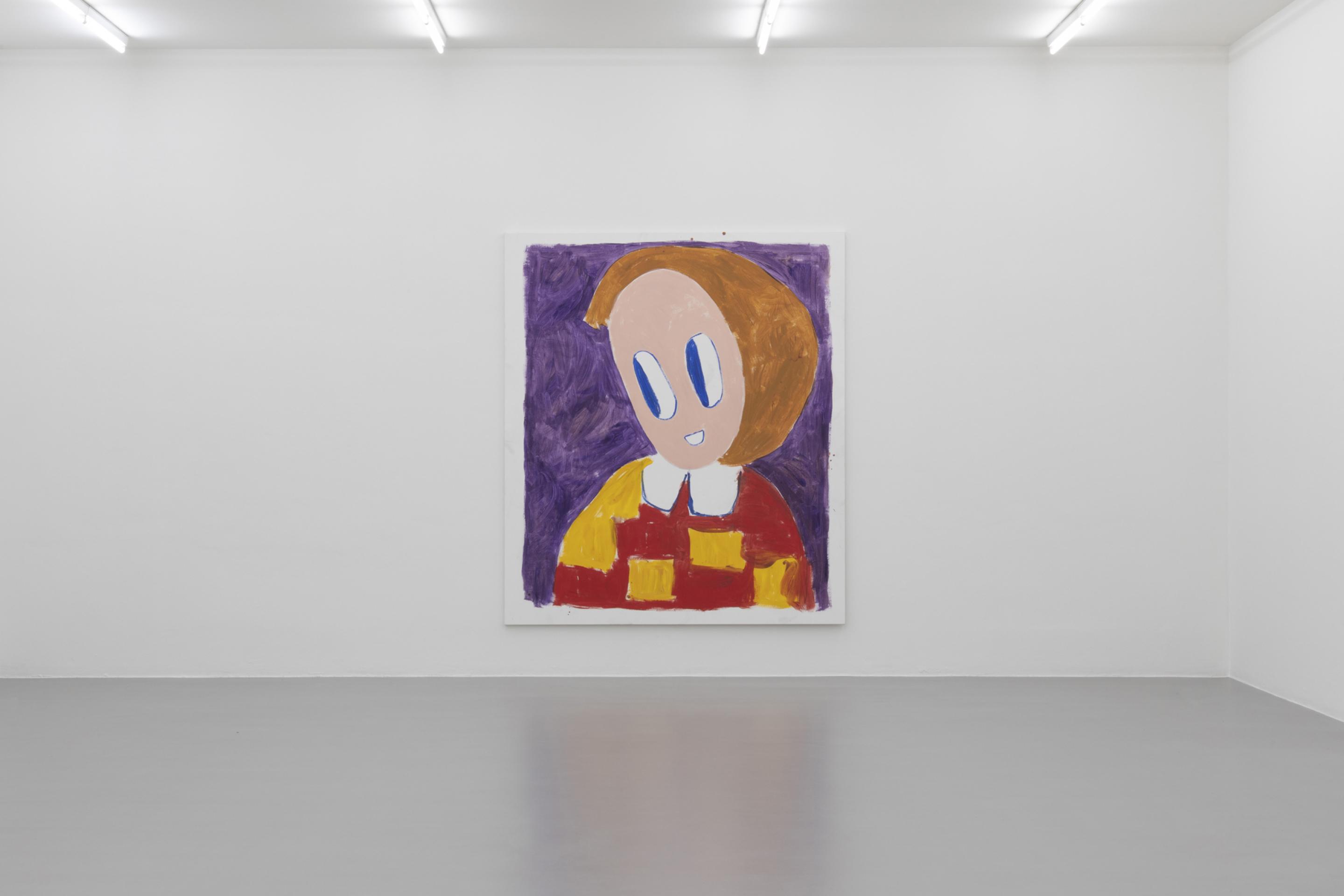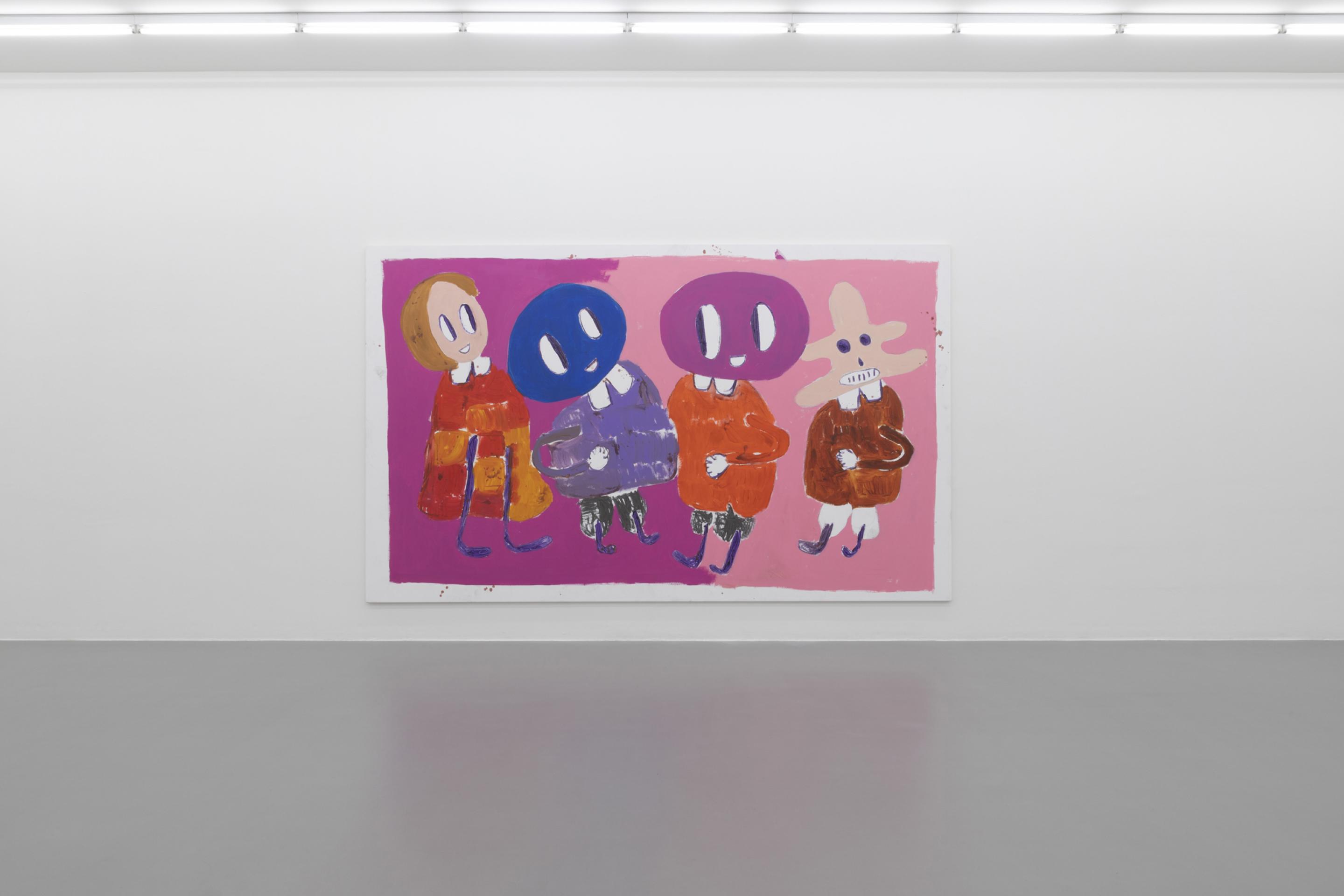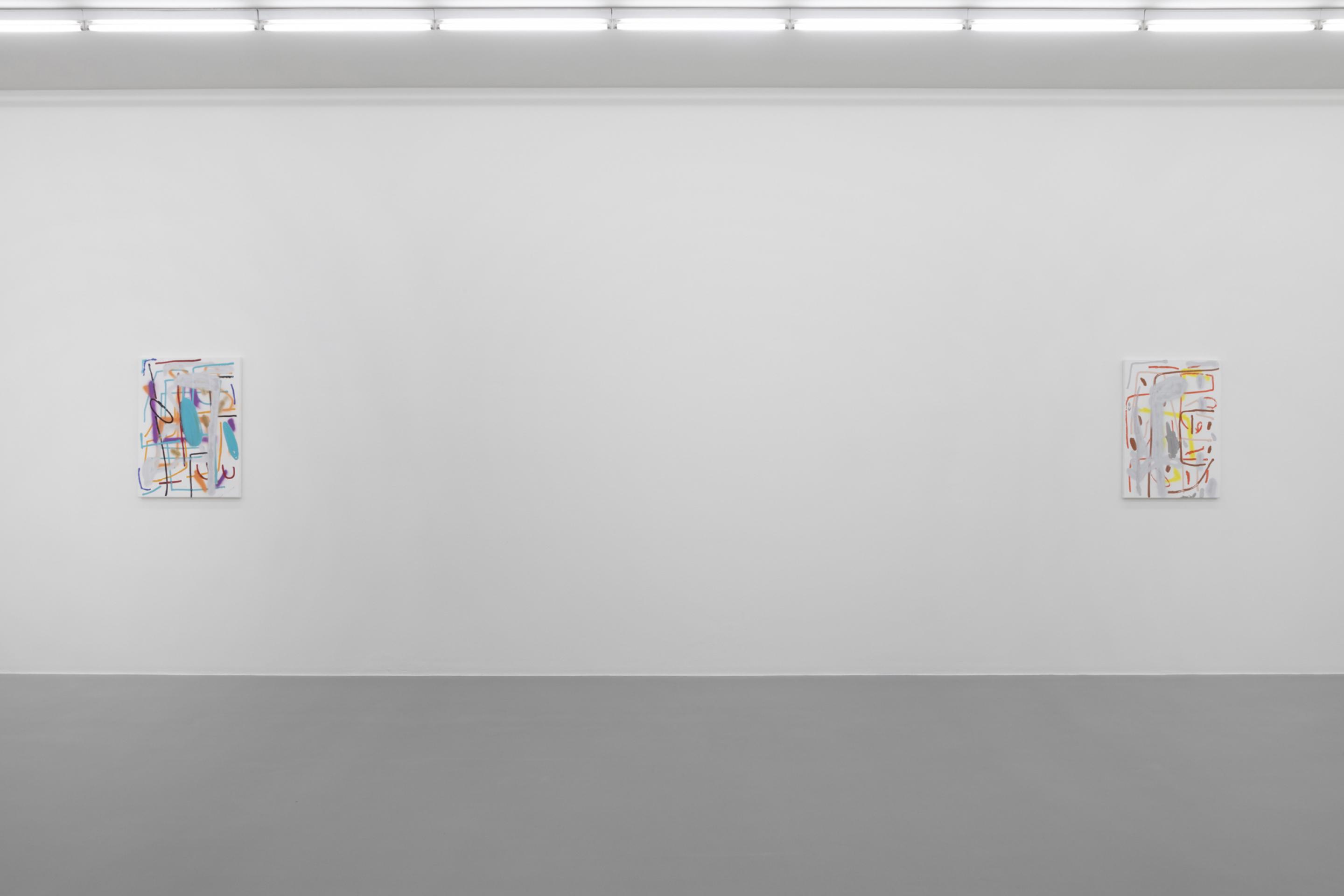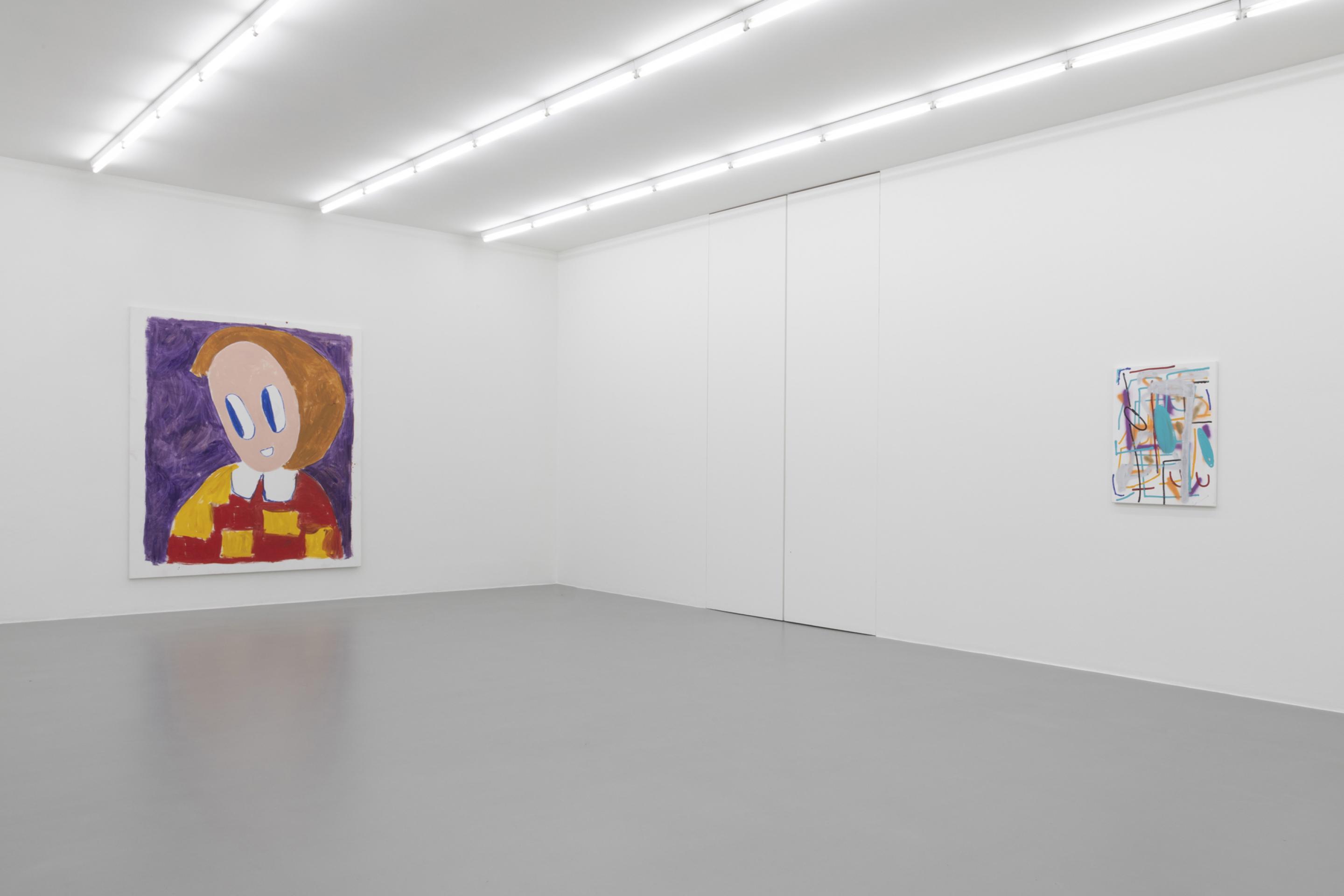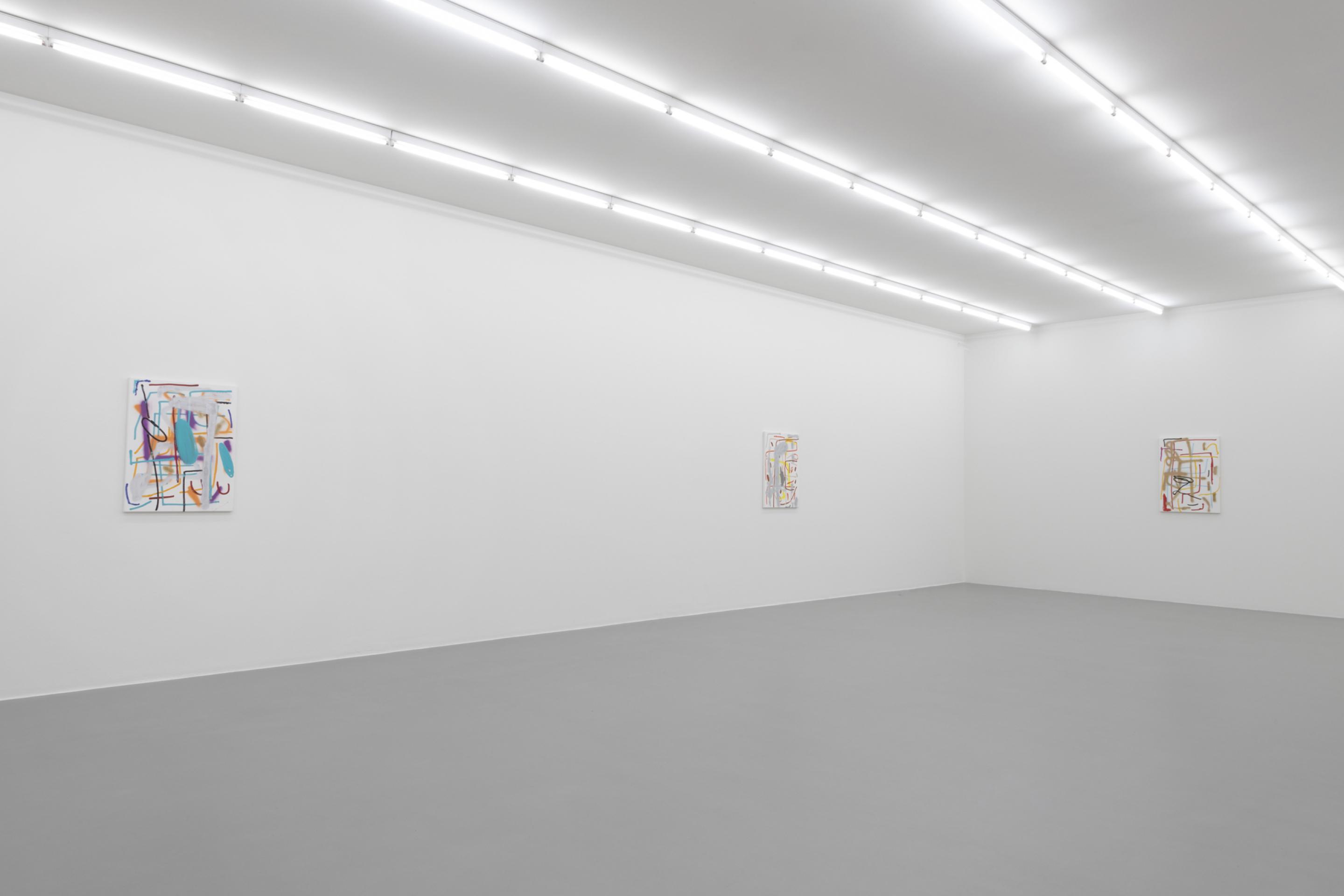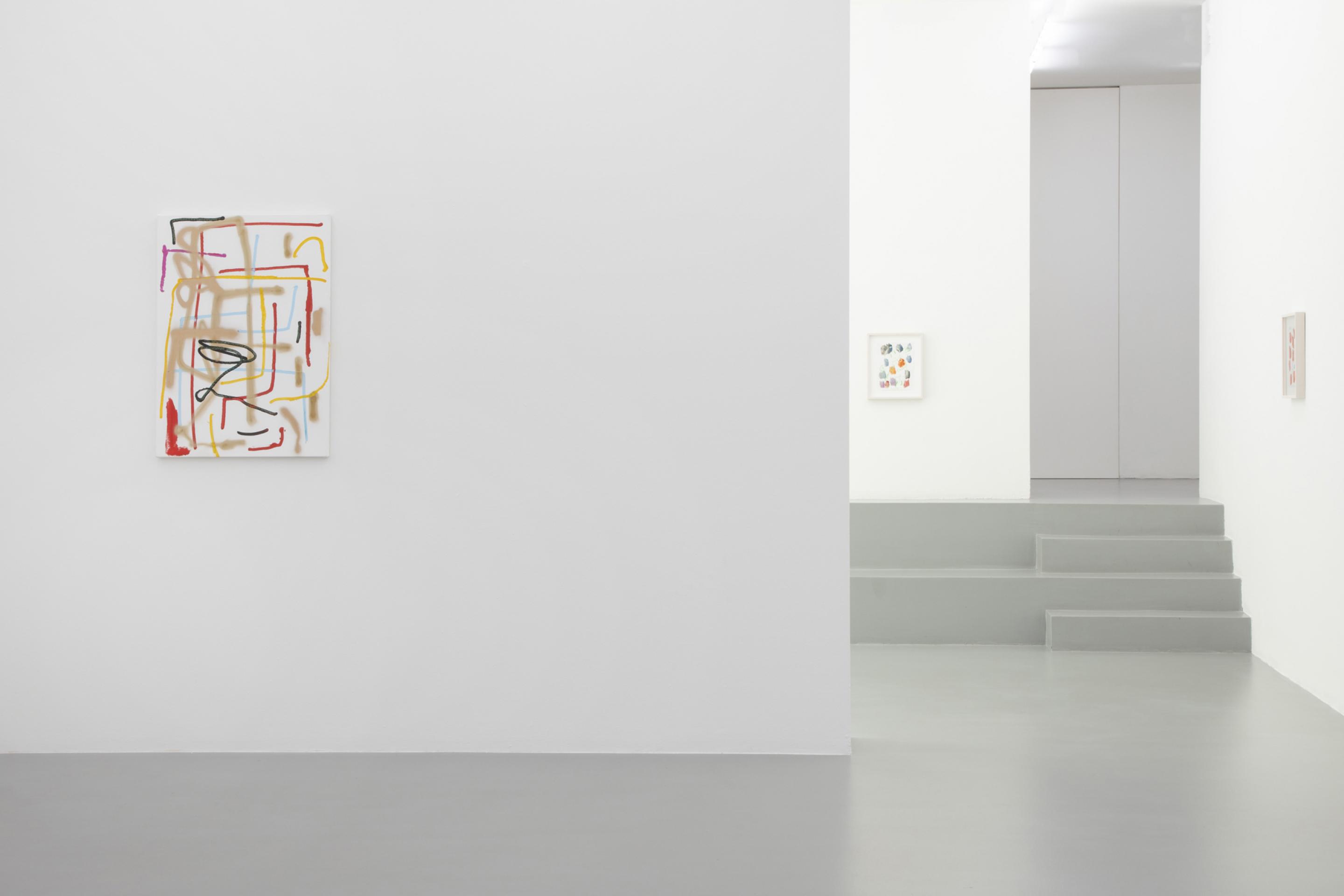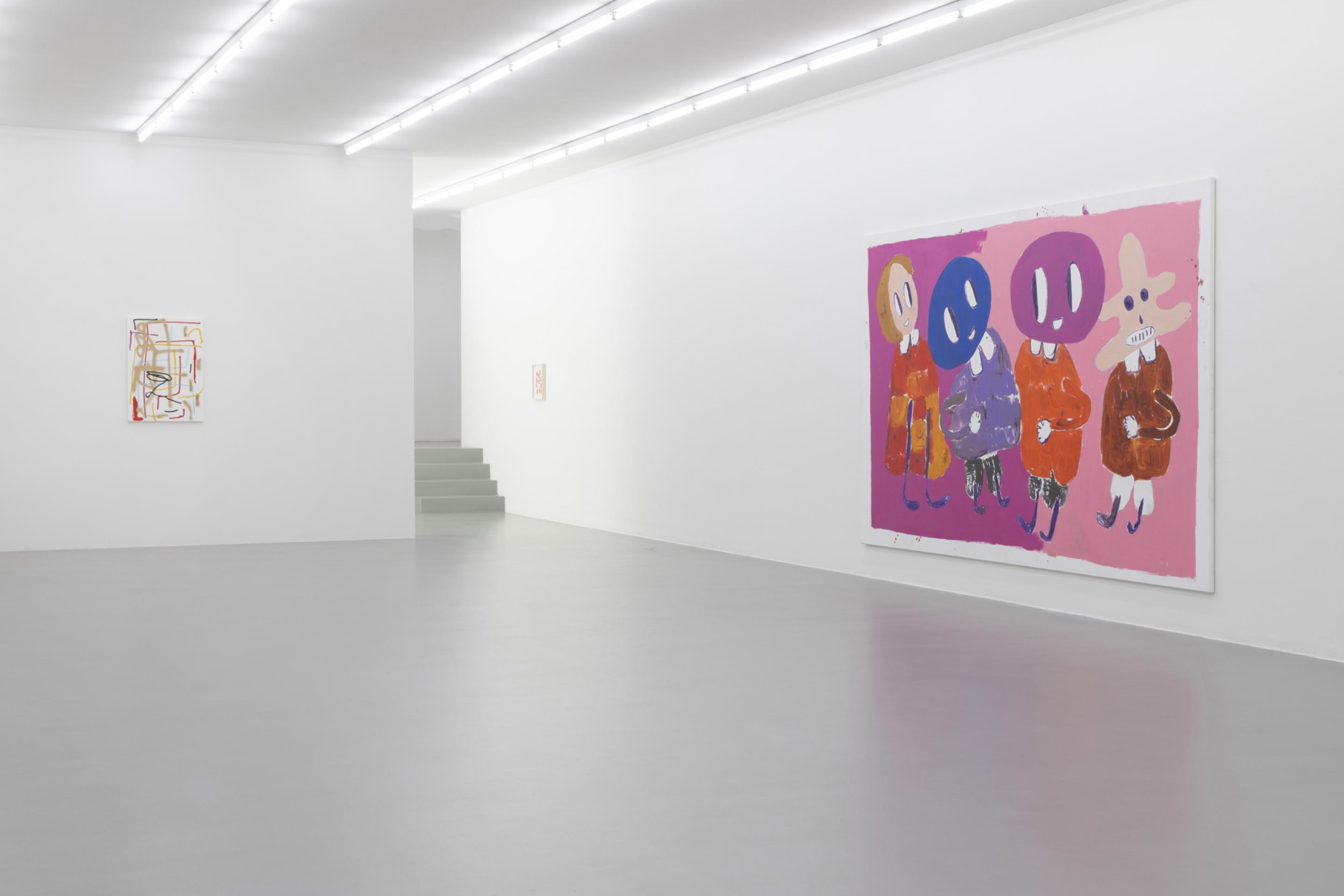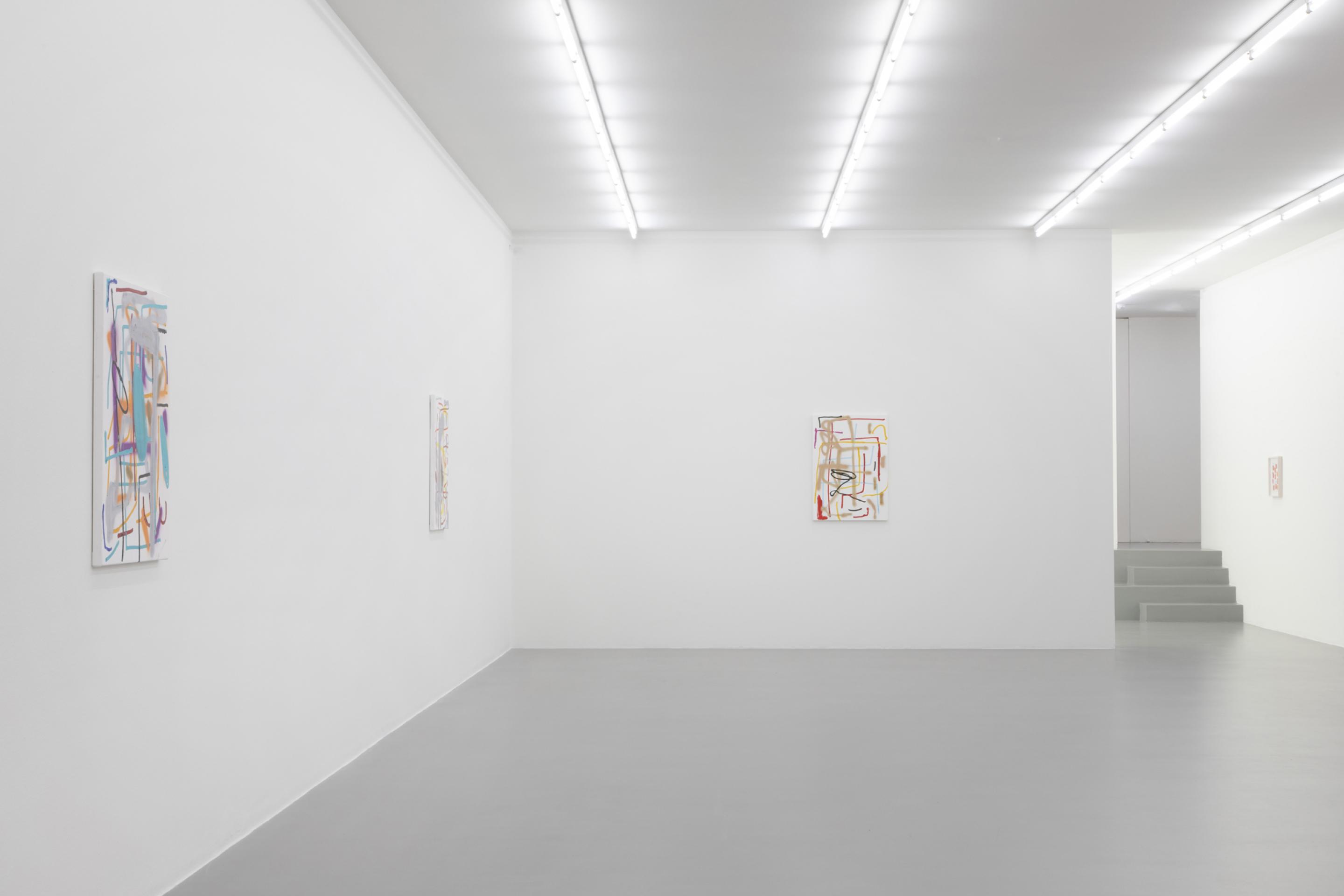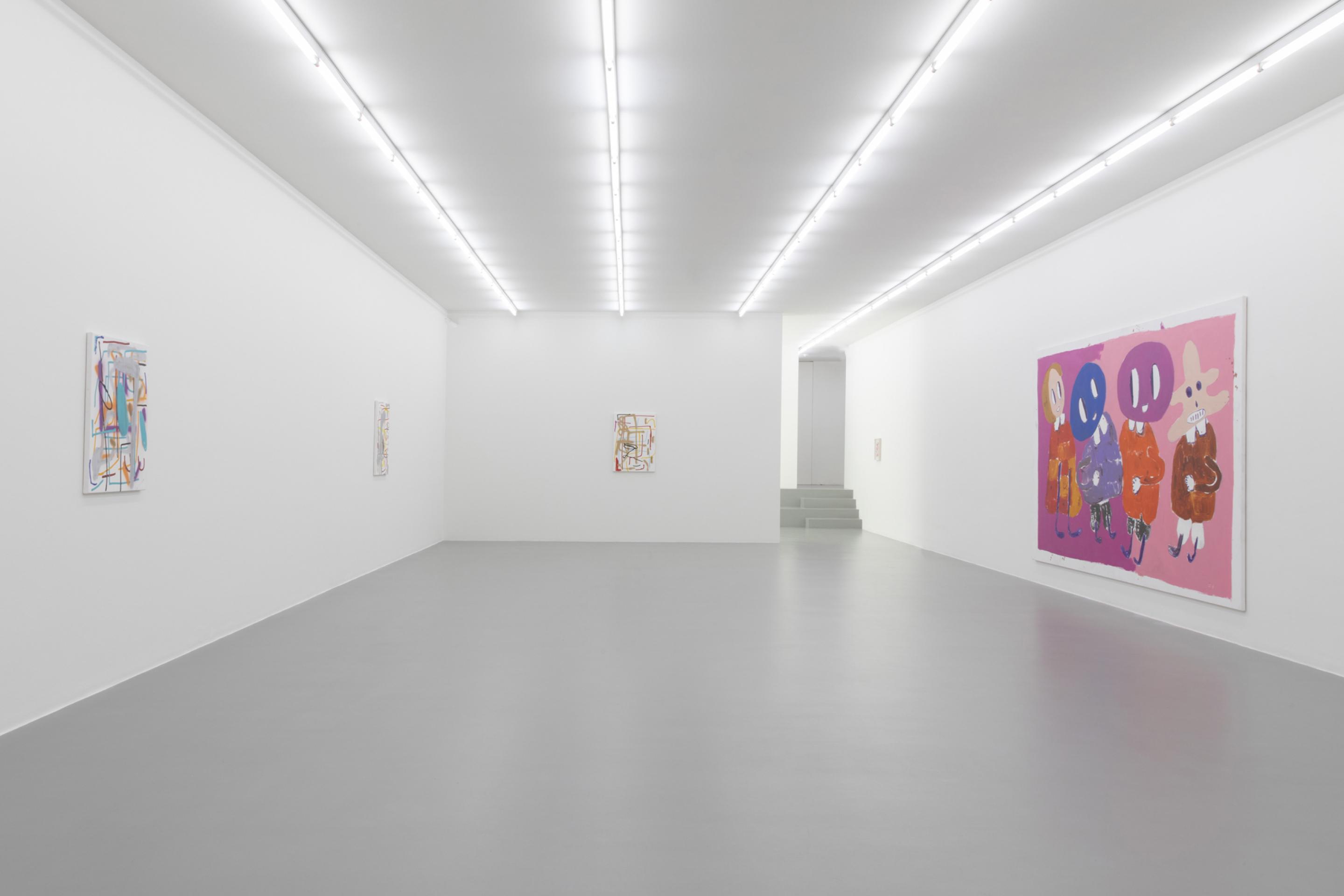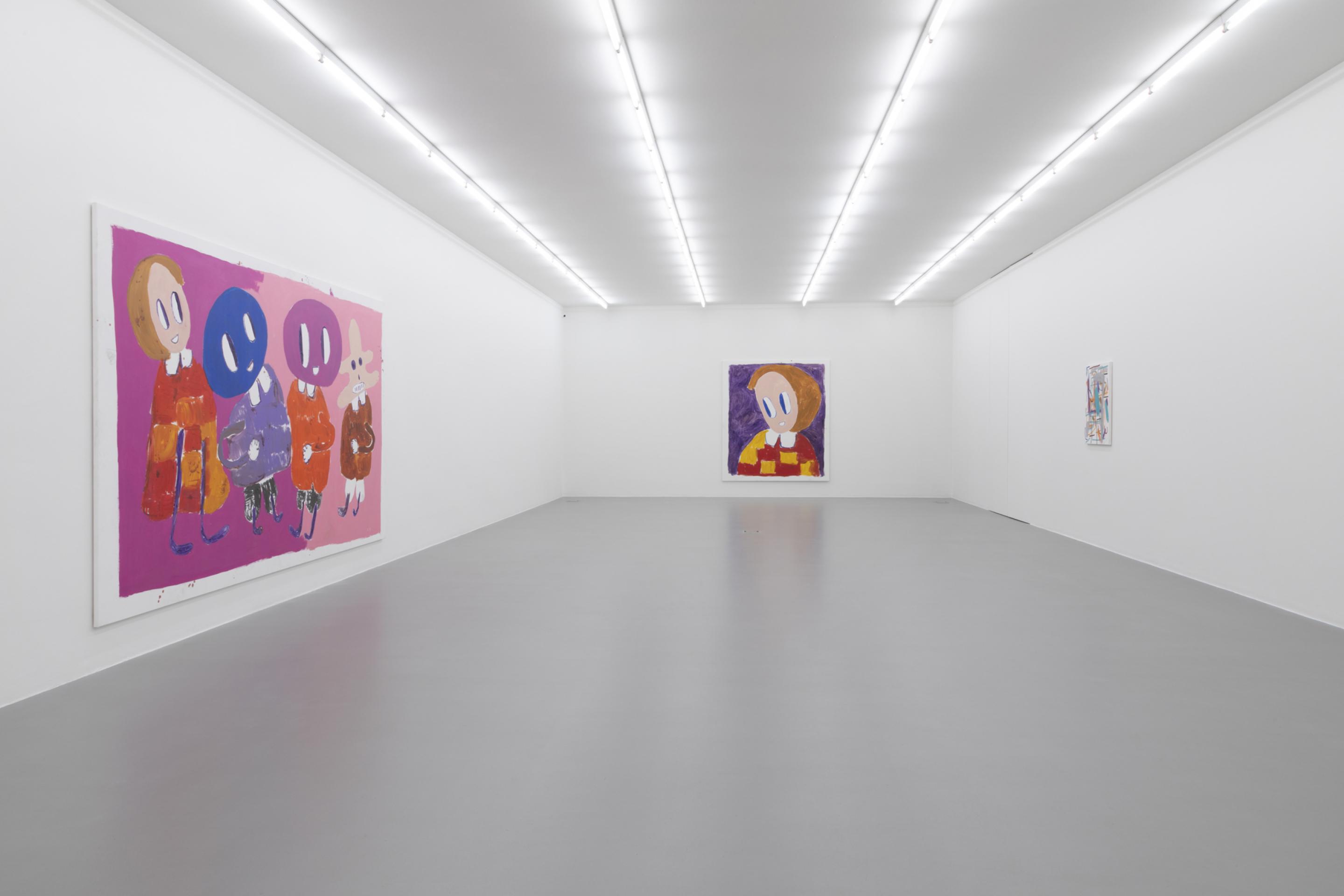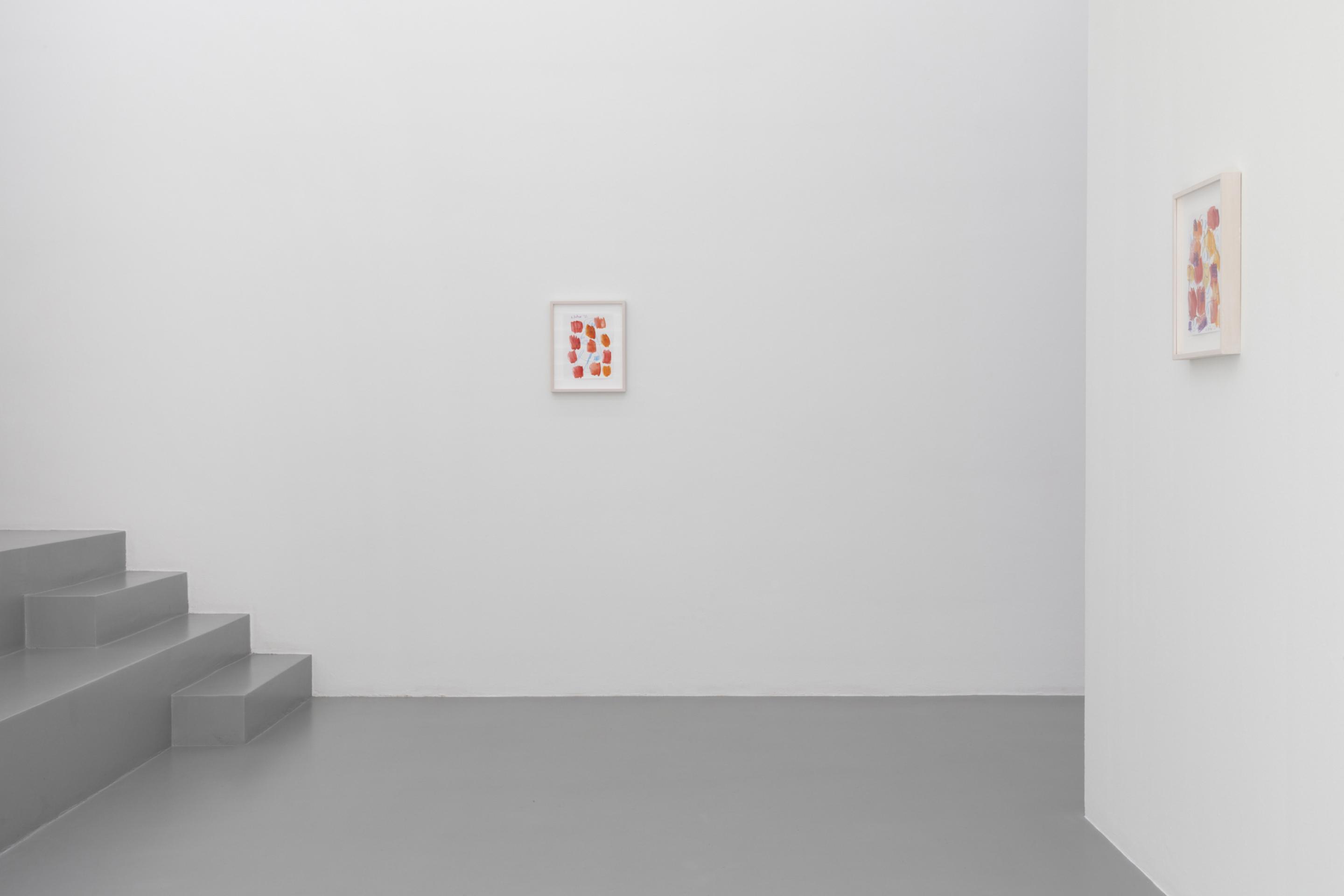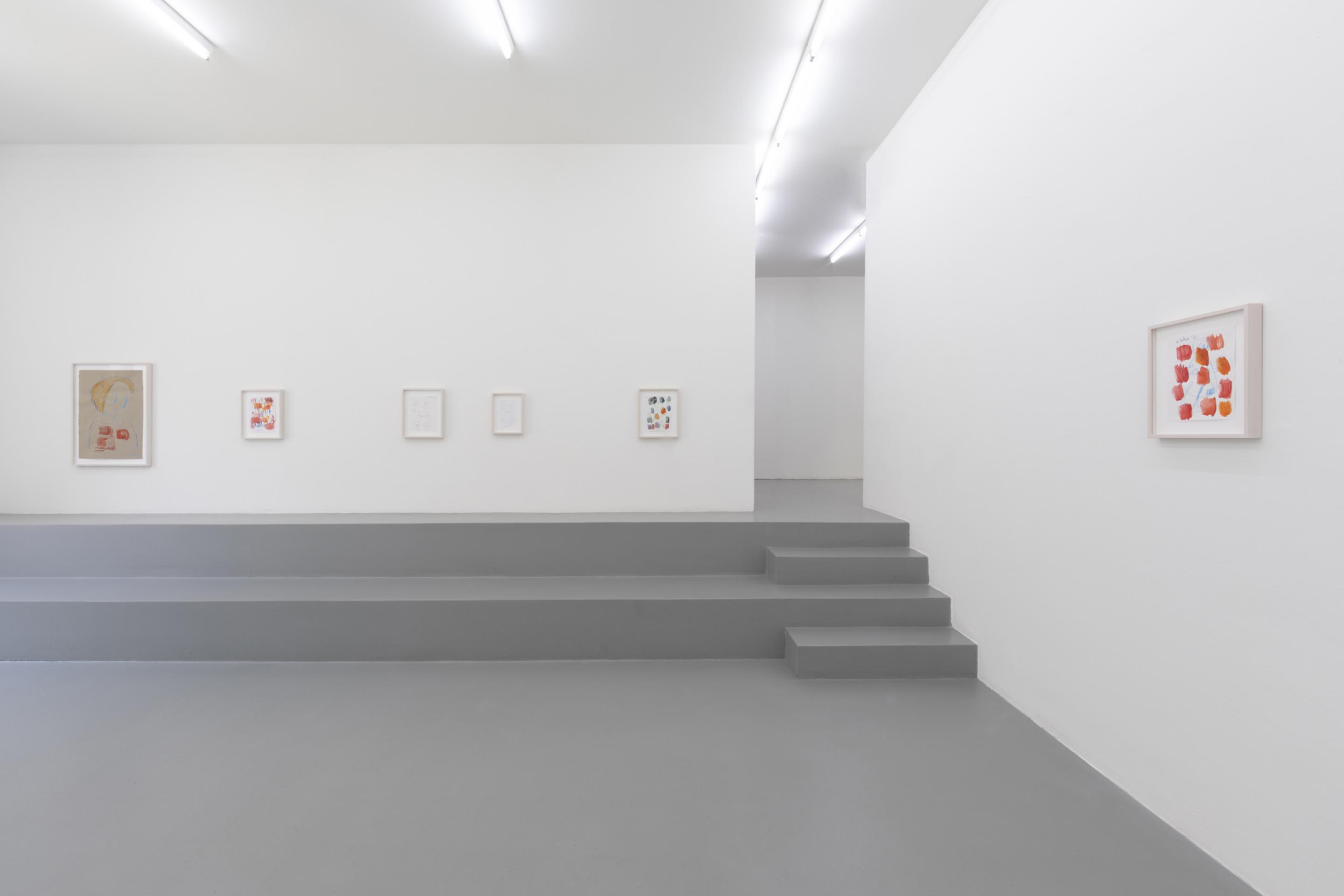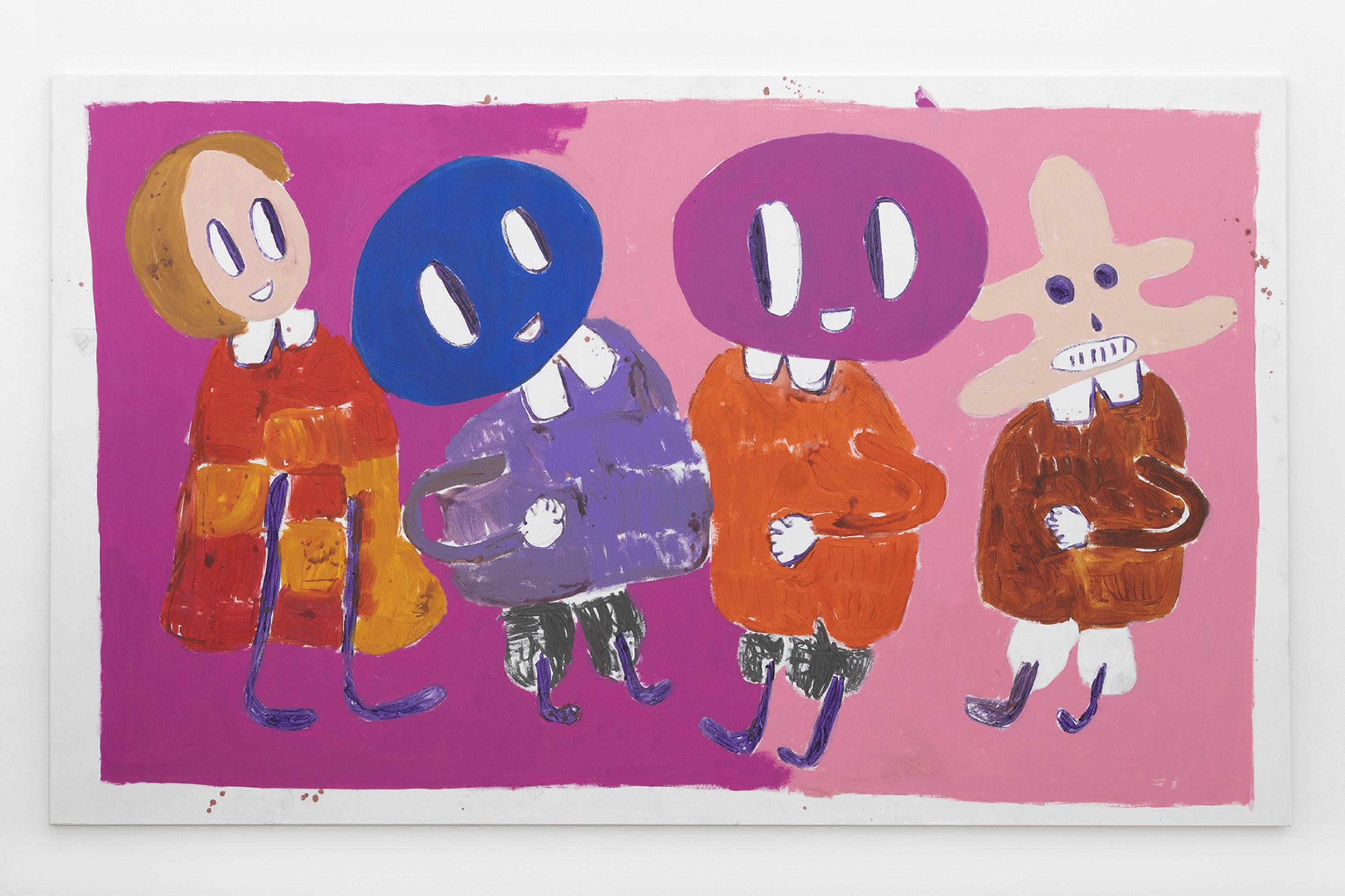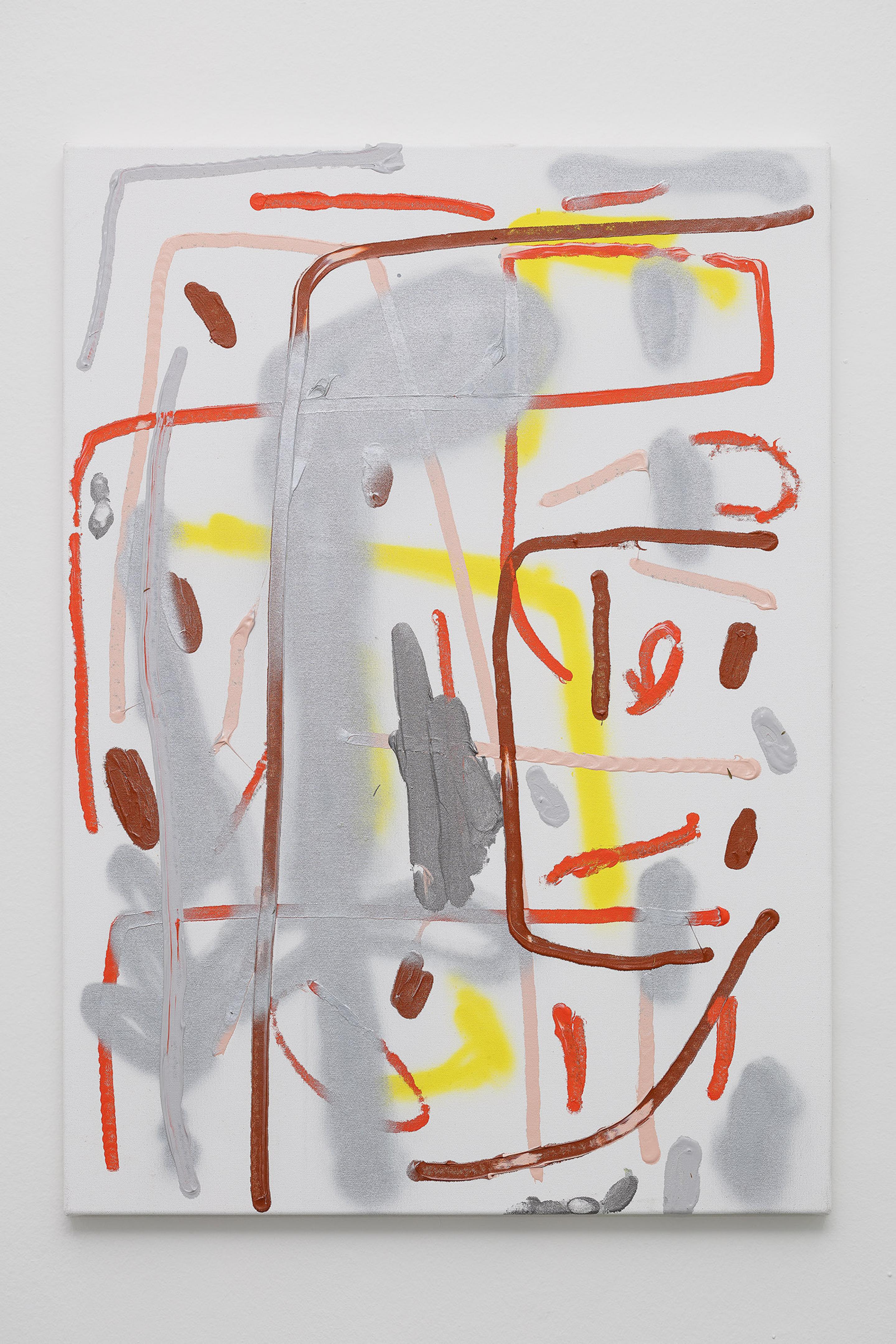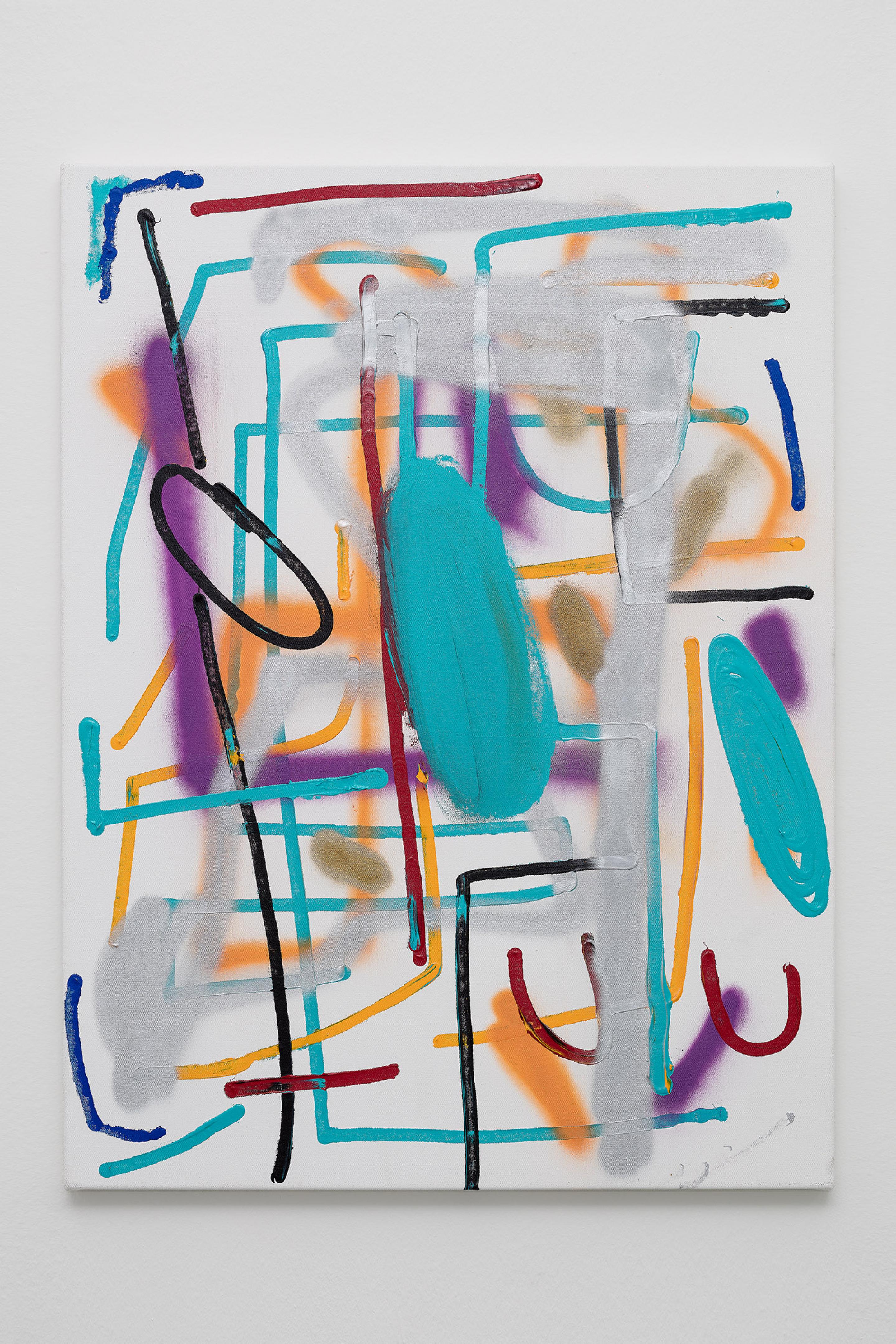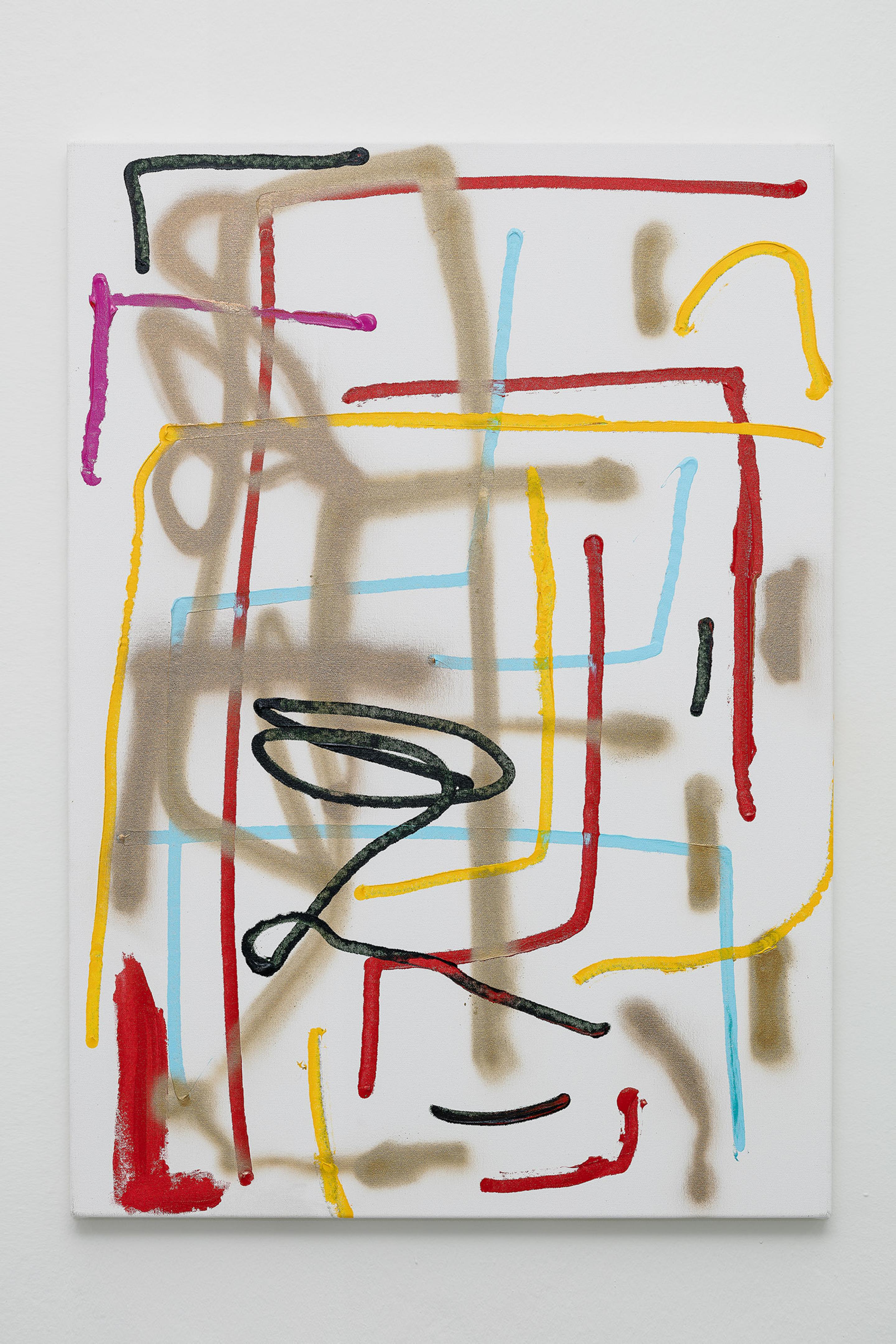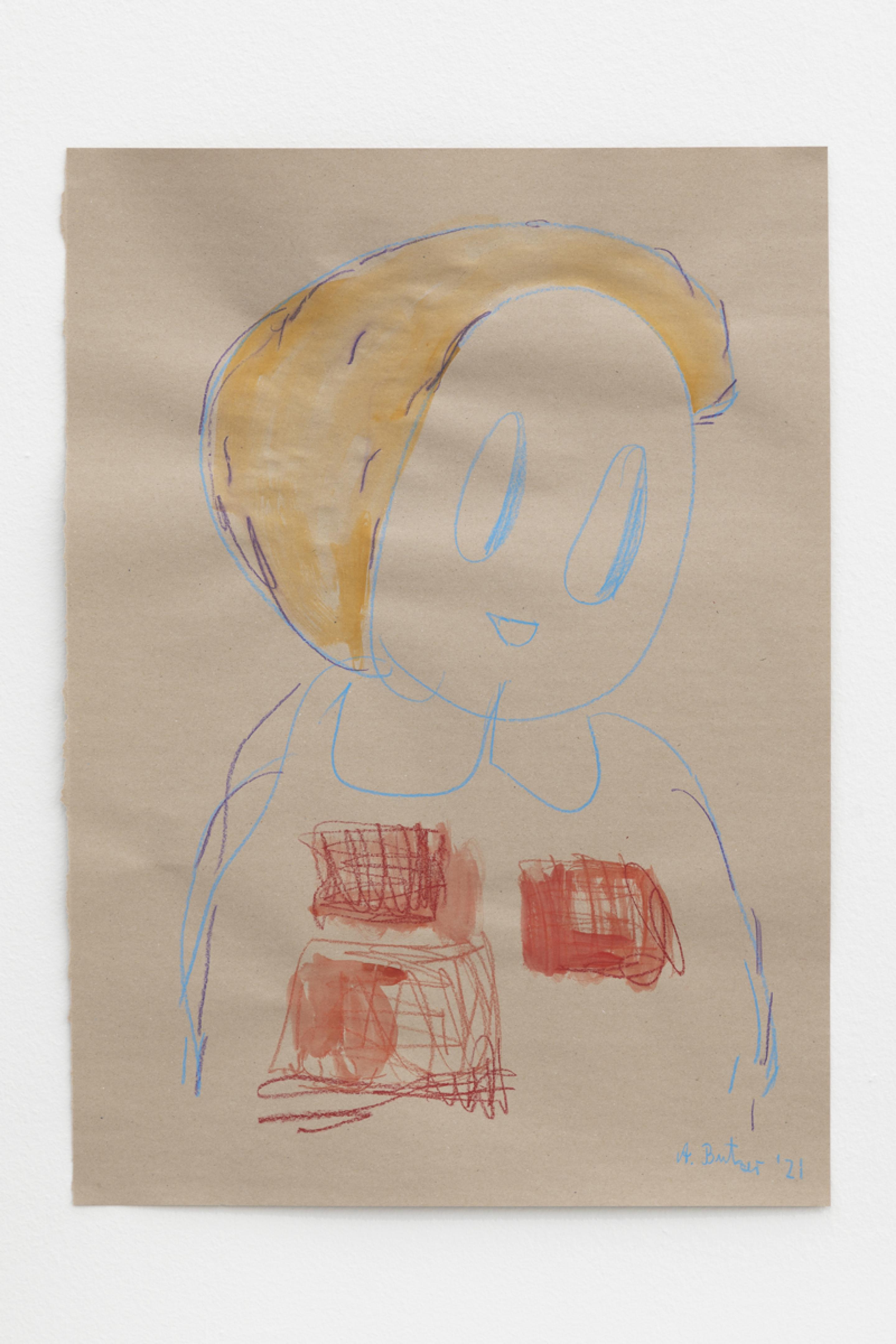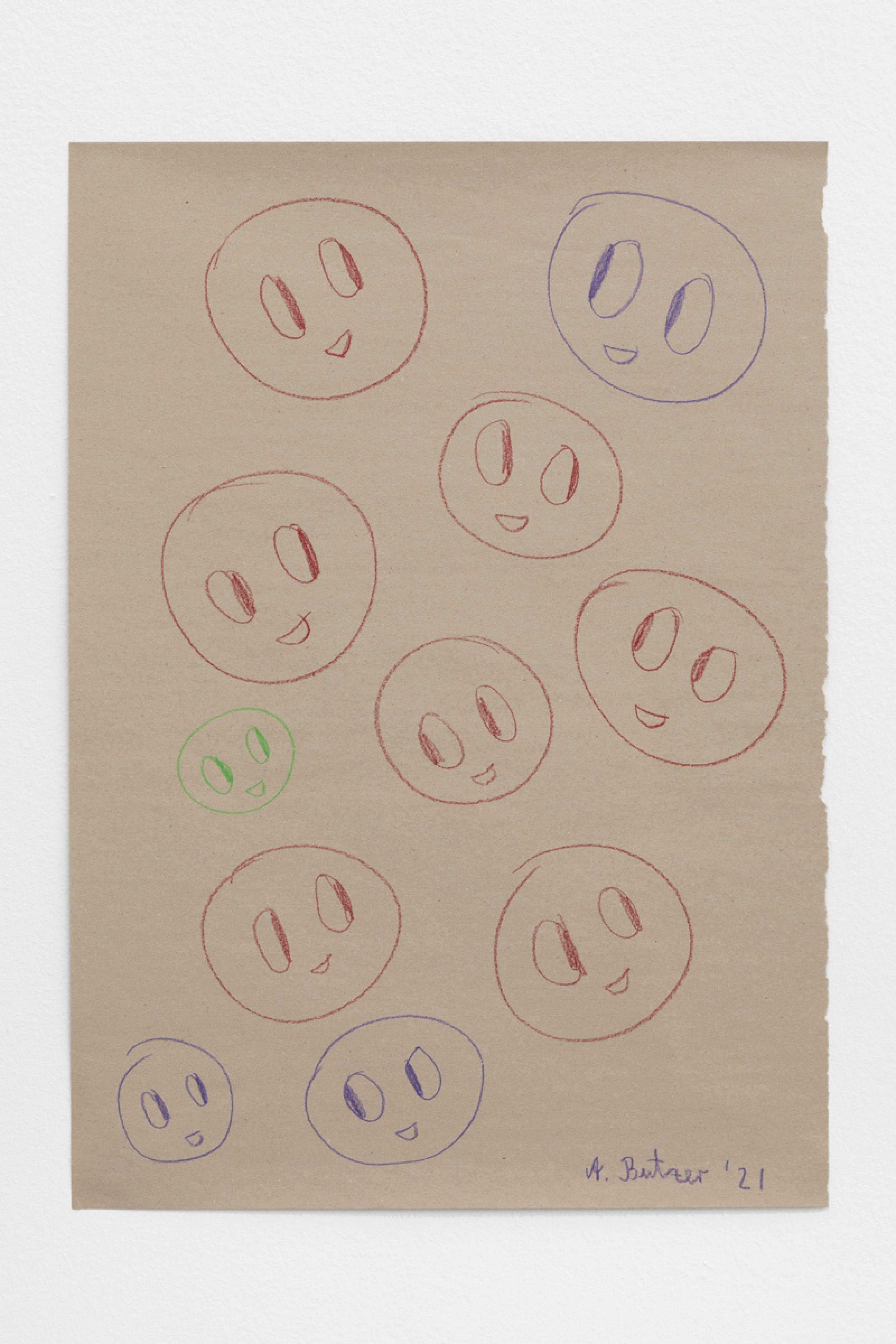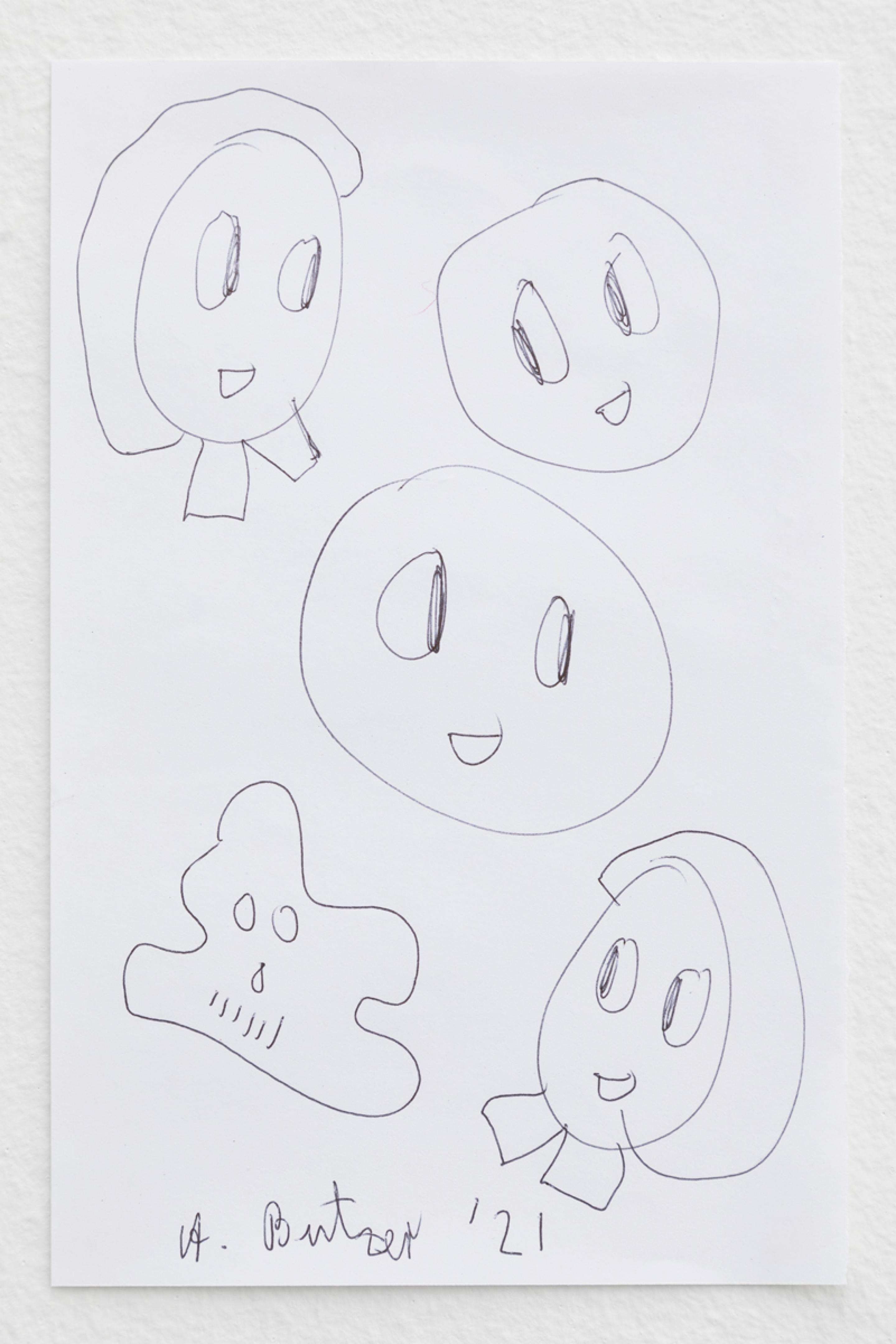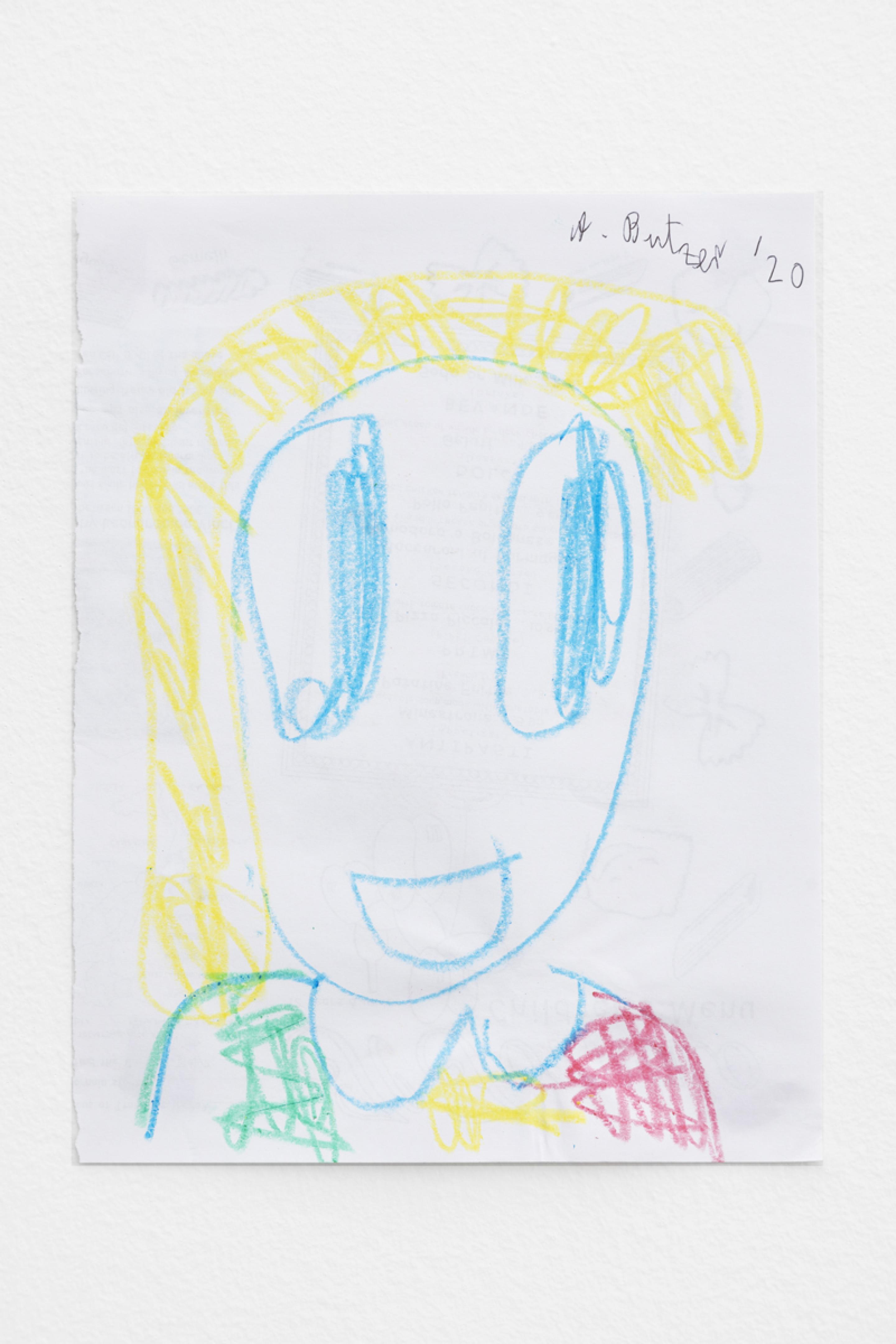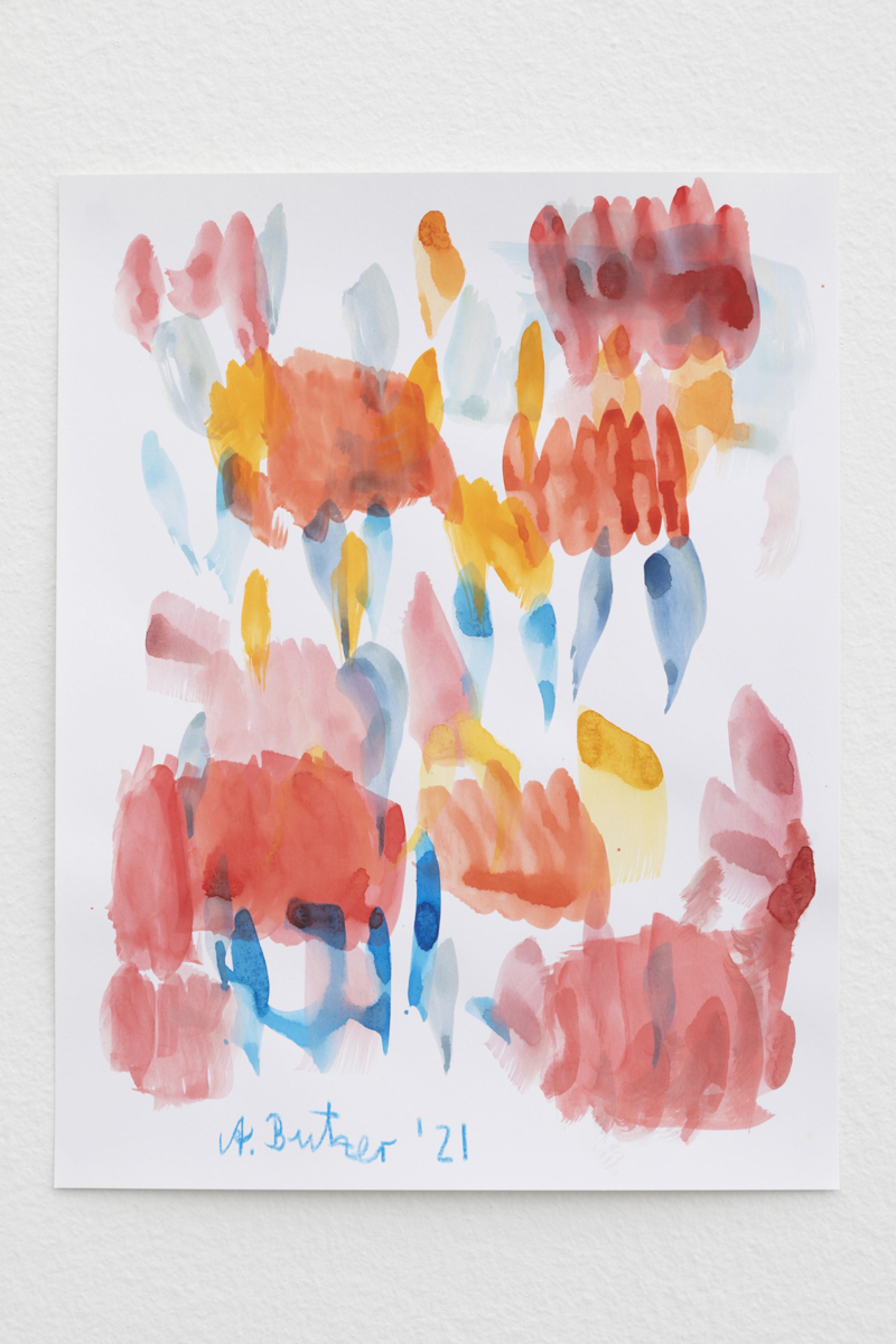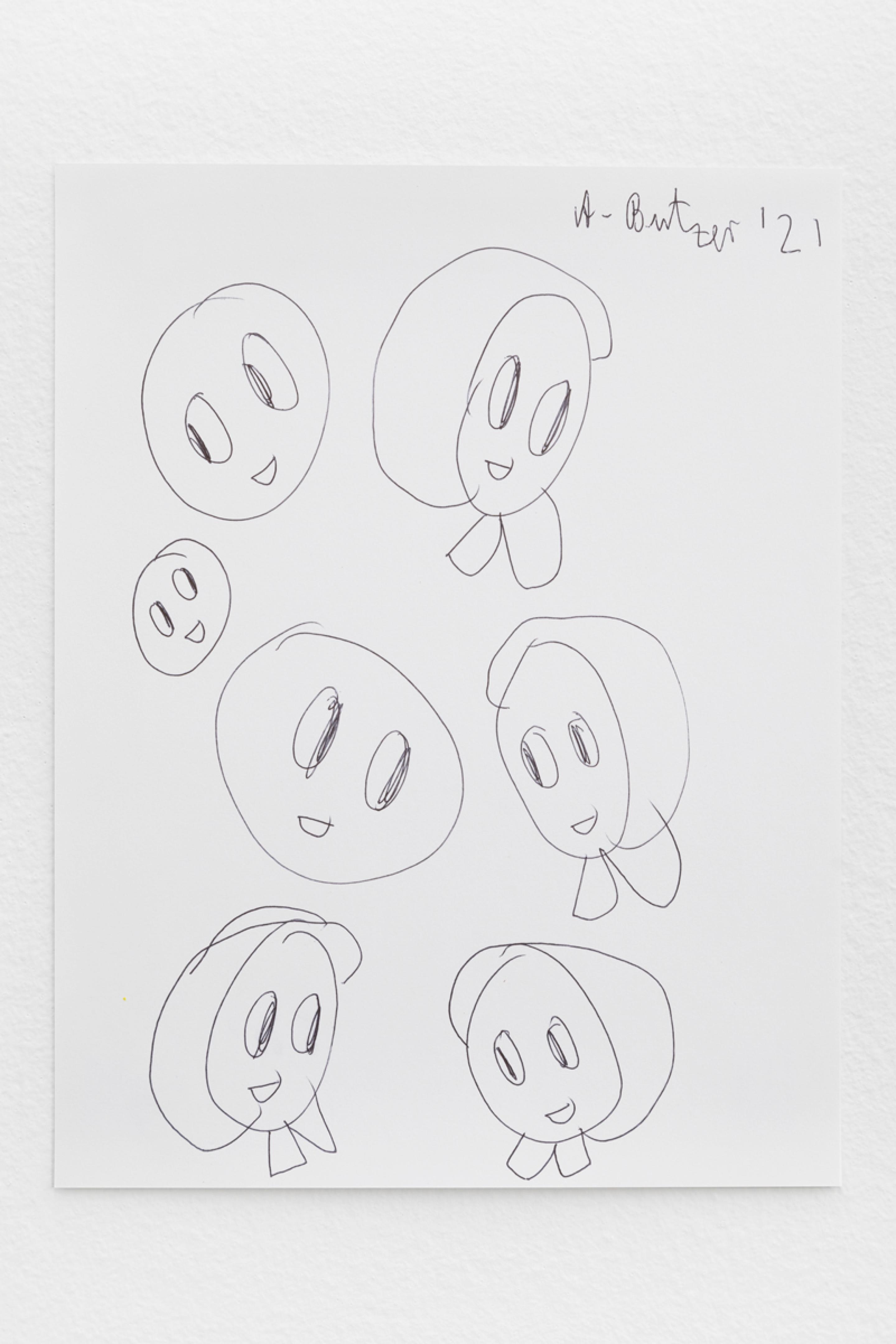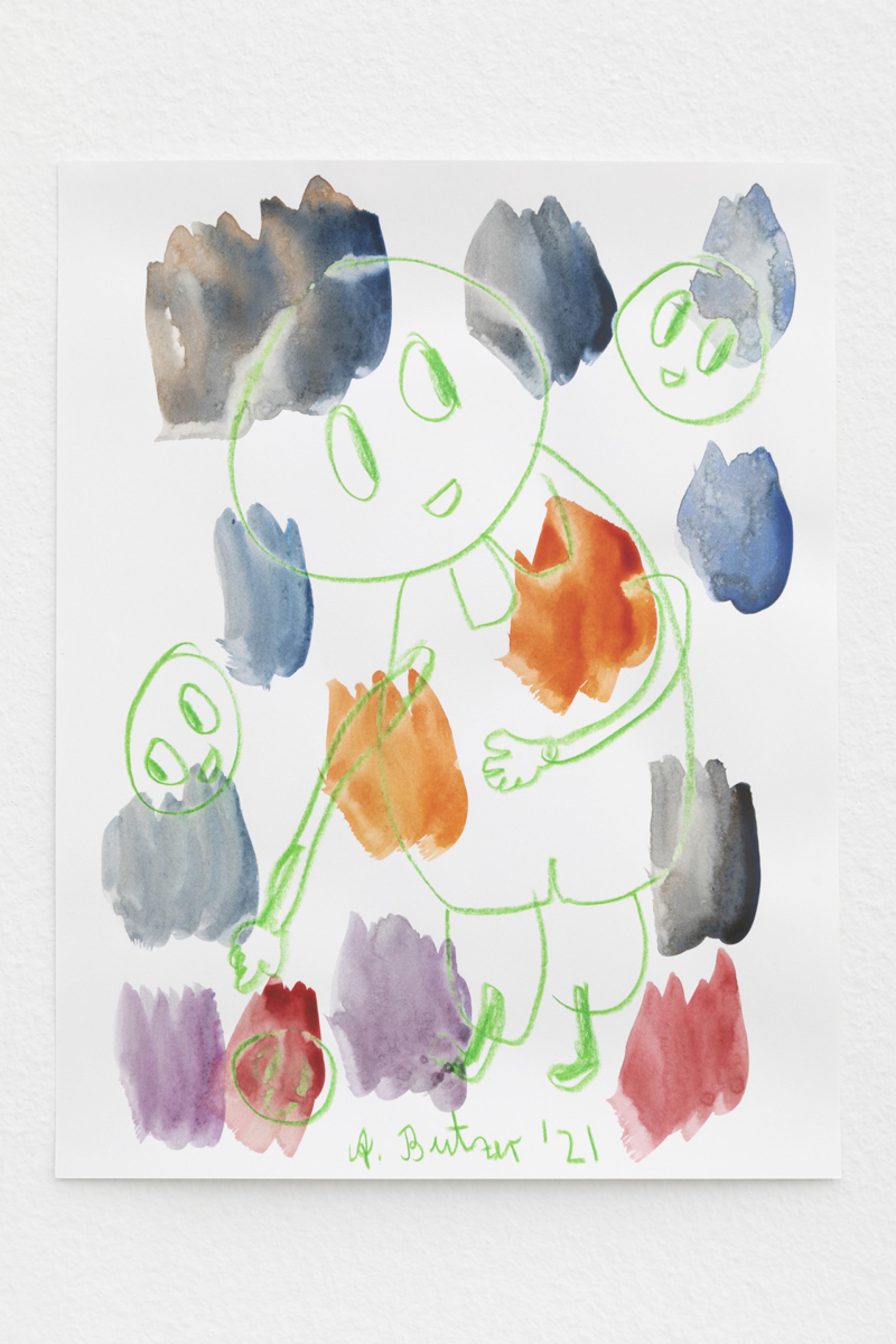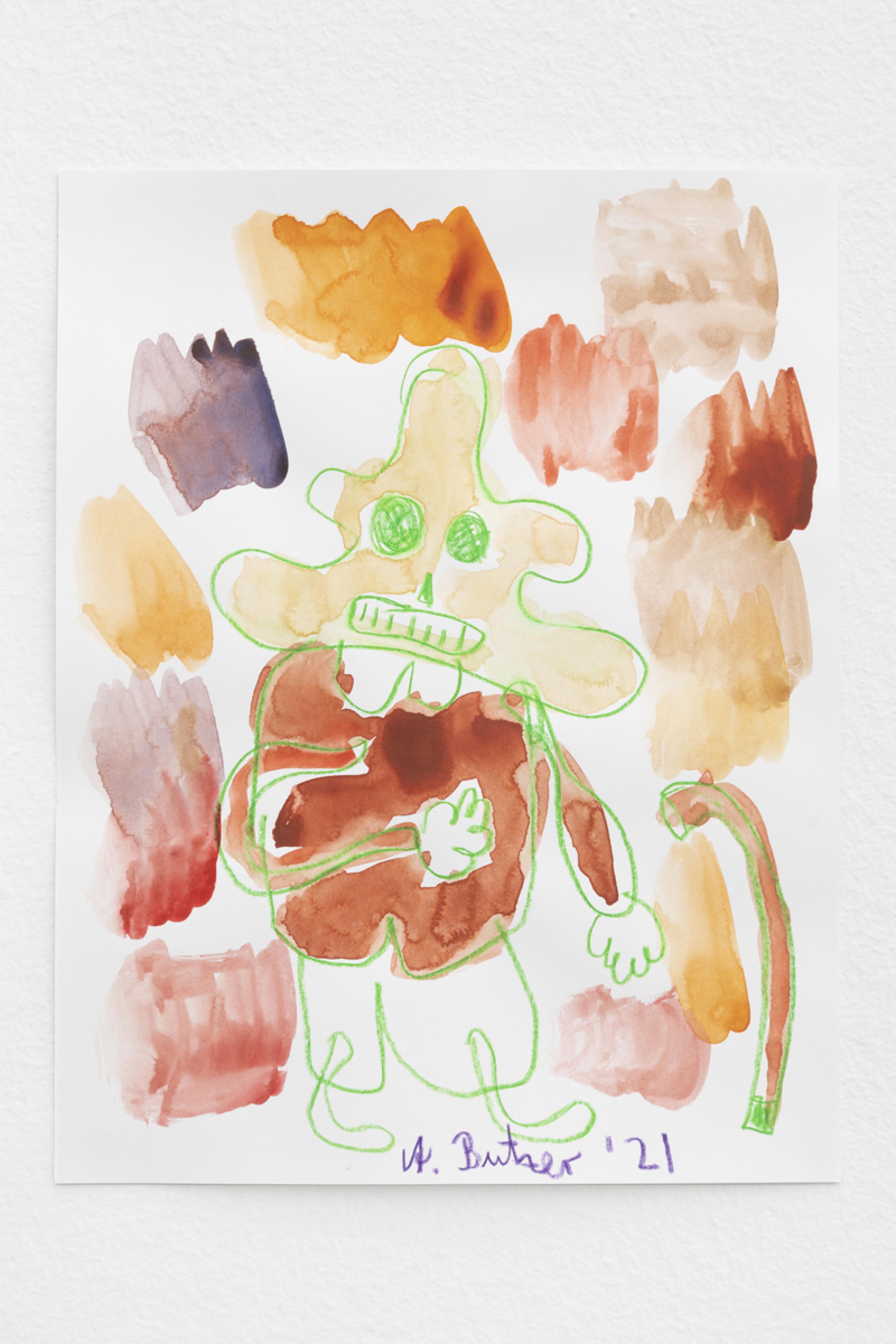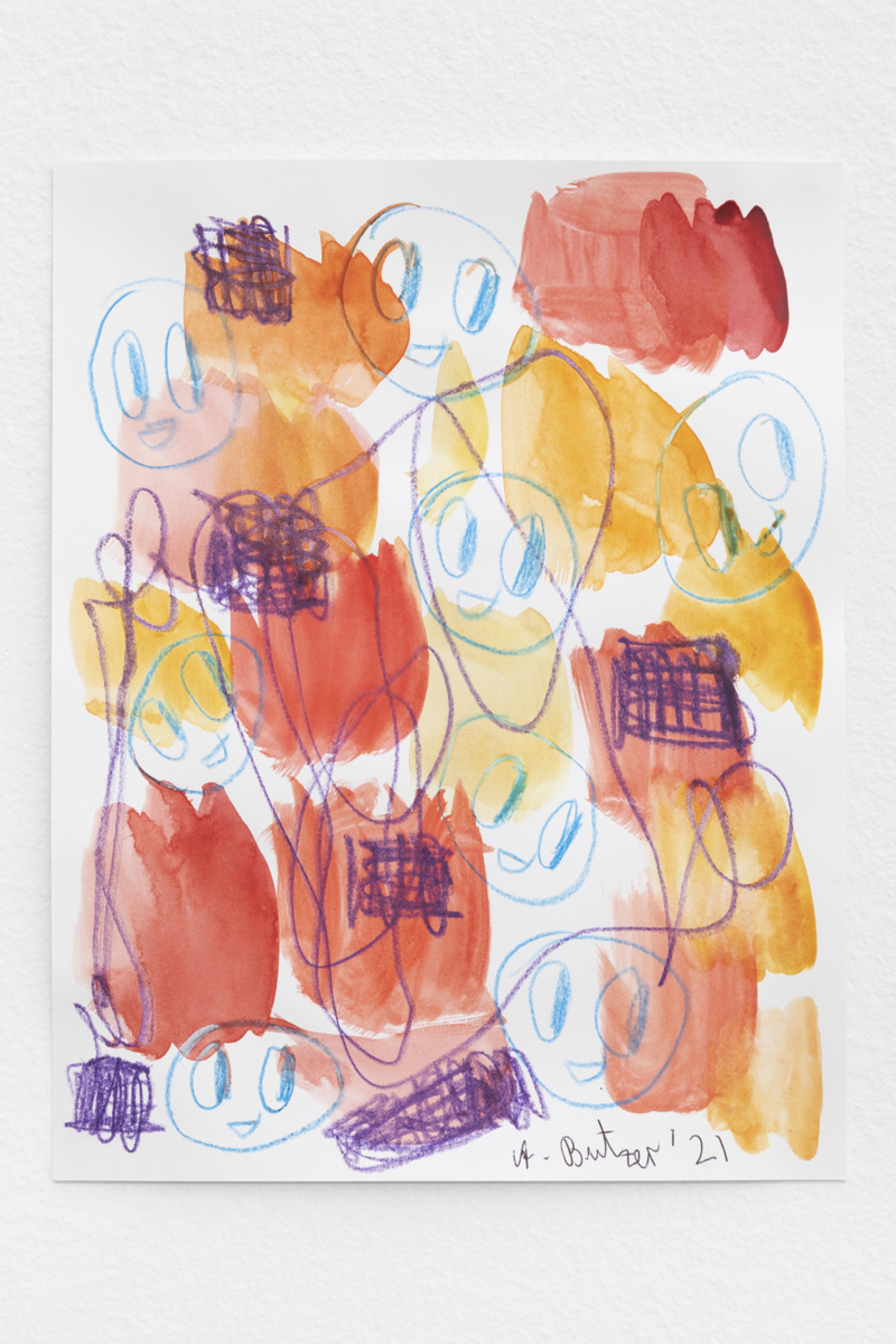AndréBUTZER
André Butzer
Gió Marconi, Milan
10.06.–23.07.2021
André Butzer
Gió Marconi, Milan
10.06.–23.07.2021
IT
André Butzer
Inaugurazione: giovedì 10 giugno dalle 11 alle 19
11 giugno – 23 luglio 2021
lunedì – venerdì; 11-19
Gió Marconi è lieto di presentare André Butzer, la quinta personale dell'artista con la galleria. In un sorprendente capovolgimento della sua mostra del 2018, che presentava per lo più opere monocromatiche nere, i dipinti N, in queste tele Butzer sceglie colori vivaci e realizza le sue figure più distintive. In mostra un gruppo di nuovi dipinti astratti e figurativi e una selezione di opere su carta.
(…) CM: Molto tempo fa hai parlato di “Tempo-Oggi” e “Tempo-Mai”.
AB: C’era questa cosa... C'è anche Tempo-Ora. Tempo-Mai è N. Oggi è Tempo-N. Oggi è sempre N.
CM: N è una visione onirica?
AB: No. N non è niente di desiderabile. In realtà è, come sappiamo, molto più difficile.
CM: Nessun posto dove stare.
AB: No.
CM: Cosa sarebbe uno stare, uno stare desiderabile?
AB: (…) Passeggiate mattutine e passeggiate serali. Stare fuori fa bene.
CM: Un "momento magico" sia dentro che fuori il tempo? O è qualcosa di diverso?
AB: Magico, tutto è magico. C'è solo magia, anche. Ma questo non ha niente a che fare con il tempo. La magia è pre-scientifica e post-scientifica. La magia è sempre.
CM: Prima e dopo la ragione?
AB: La fine della scienza. La fine delle scienze è imminente. Ora siamo pre-magici, in tempi pre-magici.
CM: Si dipinge perché il linguaggio fallisce?
AB: Come dovrei saperlo? Sto solo facendo il mio lavoro (…)
CM: La pittura nasce da immagini a ritmo?
AB: Ritmo, forse. Ma... è troppo generale.
CM: La monotonia è un tratto caratteristico dell'arte, la ripetizione, l‘iterazione?
AB: Non è mai monotono, vero? Sempre diverso. Ecco perché non è necessario fare qualcosa di diverso, ma sempre e solo la stessa cosa. Senza alcuna intenzione. Non puoi fare qualcosa di diverso intenzionalmente. È davvero, davvero brutto. Veramente. È così brutto, fare intenzionalmente le cose in modo diverso. Non dovresti farlo. Devi fare la stessa cosa.
CM: Hai pensato alla semplicità, sia nella musica che nell'arte.
AB: Non ho mi pensato ad altro.
CM: Molto semplice, quasi folcloristico. Come i Meat Puppets, che abbiamo ascoltato ieri sera. Molto semplice, ma molto complesso.
AB: Sì, sì, ma senza alcuna intenzione. Proprio come faccio io, folklore.
CM: Senza sforzo, sereno?
AB: Questo non lo so, ma sicuramente penso che in entrambi i casi sia arte popolare. Devi dire altrettanto.
CM: È questa la verità?
AB: Sì, la verità è tutto ciò di cui si tratta. Vicinanza alla verità. Mentire non è interessante. Alcune persone si sono occupate di bugie per molto tempo. Non lo facciamo più, invece facciamo arte popolar-verità.
CM: Il passato aiuta?
AB: Sempre.
CM: Il futuro aiuta?
AB: In ogni caso.
CM: Entrambi insieme?
AB: Si tratta di conservazione. Anche il futuro deve essere conservato. (…)
Altadena, California, 13–14 gennaio 2021
André Butzer (n. 1973, Stoccarda) vive e lavora a Berlino. Dal 1996 i suoi dipinti sono stati oggetto di numerose mostre istituzionali. Tra le mostre personali: IKOB Museum of Contemporary Art, Eupen, Belgio; Kestnergesellschaft, Hannover, Germania; Kunsthalle Nuremberg, Norimberga, Germania; Kunstverein Reutlingen, Reutlingen, Germania; Museum of the Light, Hokuto, Giappone; Växjö Konsthall, Växjö, Svezia; YUZ Museum, Shanghai, Cina. Le sue opere fanno parte, tra le altre, delle collezioni dell’Art Institute of Chicago, Chicago, USA; Carré d’Art, Nîmes, Francia; Contemporary Art Collection of the Federal Republic of Germany, Bonn, Germania; Deichtorhallen Hamburg, Amburgo, Germania; Hall Art Foundation, Reading, UK; Kupferstichkabinett, Berlin State Museums, Berlino, Germania; Nationalgalerie / Hamburger Bahnhof –Museum für Gegenwart, Berlino, Germania; LACMA, Los Angeles, USA; MOCA, Los Angeles, USA; Paula Modersohn-Becker Museum, Brema, Germania; Rubell Museum, Miami, USA; YUZ Museum, Shanghai, Cina.
Inaugurazione: giovedì 10 giugno dalle 11 alle 19
11 giugno – 23 luglio 2021
lunedì – venerdì; 11-19
Gió Marconi è lieto di presentare André Butzer, la quinta personale dell'artista con la galleria. In un sorprendente capovolgimento della sua mostra del 2018, che presentava per lo più opere monocromatiche nere, i dipinti N, in queste tele Butzer sceglie colori vivaci e realizza le sue figure più distintive. In mostra un gruppo di nuovi dipinti astratti e figurativi e una selezione di opere su carta.
(…) CM: Molto tempo fa hai parlato di “Tempo-Oggi” e “Tempo-Mai”.
AB: C’era questa cosa... C'è anche Tempo-Ora. Tempo-Mai è N. Oggi è Tempo-N. Oggi è sempre N.
CM: N è una visione onirica?
AB: No. N non è niente di desiderabile. In realtà è, come sappiamo, molto più difficile.
CM: Nessun posto dove stare.
AB: No.
CM: Cosa sarebbe uno stare, uno stare desiderabile?
AB: (…) Passeggiate mattutine e passeggiate serali. Stare fuori fa bene.
CM: Un "momento magico" sia dentro che fuori il tempo? O è qualcosa di diverso?
AB: Magico, tutto è magico. C'è solo magia, anche. Ma questo non ha niente a che fare con il tempo. La magia è pre-scientifica e post-scientifica. La magia è sempre.
CM: Prima e dopo la ragione?
AB: La fine della scienza. La fine delle scienze è imminente. Ora siamo pre-magici, in tempi pre-magici.
CM: Si dipinge perché il linguaggio fallisce?
AB: Come dovrei saperlo? Sto solo facendo il mio lavoro (…)
CM: La pittura nasce da immagini a ritmo?
AB: Ritmo, forse. Ma... è troppo generale.
CM: La monotonia è un tratto caratteristico dell'arte, la ripetizione, l‘iterazione?
AB: Non è mai monotono, vero? Sempre diverso. Ecco perché non è necessario fare qualcosa di diverso, ma sempre e solo la stessa cosa. Senza alcuna intenzione. Non puoi fare qualcosa di diverso intenzionalmente. È davvero, davvero brutto. Veramente. È così brutto, fare intenzionalmente le cose in modo diverso. Non dovresti farlo. Devi fare la stessa cosa.
CM: Hai pensato alla semplicità, sia nella musica che nell'arte.
AB: Non ho mi pensato ad altro.
CM: Molto semplice, quasi folcloristico. Come i Meat Puppets, che abbiamo ascoltato ieri sera. Molto semplice, ma molto complesso.
AB: Sì, sì, ma senza alcuna intenzione. Proprio come faccio io, folklore.
CM: Senza sforzo, sereno?
AB: Questo non lo so, ma sicuramente penso che in entrambi i casi sia arte popolare. Devi dire altrettanto.
CM: È questa la verità?
AB: Sì, la verità è tutto ciò di cui si tratta. Vicinanza alla verità. Mentire non è interessante. Alcune persone si sono occupate di bugie per molto tempo. Non lo facciamo più, invece facciamo arte popolar-verità.
CM: Il passato aiuta?
AB: Sempre.
CM: Il futuro aiuta?
AB: In ogni caso.
CM: Entrambi insieme?
AB: Si tratta di conservazione. Anche il futuro deve essere conservato. (…)
Altadena, California, 13–14 gennaio 2021
André Butzer (n. 1973, Stoccarda) vive e lavora a Berlino. Dal 1996 i suoi dipinti sono stati oggetto di numerose mostre istituzionali. Tra le mostre personali: IKOB Museum of Contemporary Art, Eupen, Belgio; Kestnergesellschaft, Hannover, Germania; Kunsthalle Nuremberg, Norimberga, Germania; Kunstverein Reutlingen, Reutlingen, Germania; Museum of the Light, Hokuto, Giappone; Växjö Konsthall, Växjö, Svezia; YUZ Museum, Shanghai, Cina. Le sue opere fanno parte, tra le altre, delle collezioni dell’Art Institute of Chicago, Chicago, USA; Carré d’Art, Nîmes, Francia; Contemporary Art Collection of the Federal Republic of Germany, Bonn, Germania; Deichtorhallen Hamburg, Amburgo, Germania; Hall Art Foundation, Reading, UK; Kupferstichkabinett, Berlin State Museums, Berlino, Germania; Nationalgalerie / Hamburger Bahnhof –Museum für Gegenwart, Berlino, Germania; LACMA, Los Angeles, USA; MOCA, Los Angeles, USA; Paula Modersohn-Becker Museum, Brema, Germania; Rubell Museum, Miami, USA; YUZ Museum, Shanghai, Cina.
EN
André Butzer
Opening: Thursday, June 10, 2021; 11am-7pm
June 11 - July 23, 2021
From Monday to Friday; 11am-7pm
Gió Marconi is pleased to present André Butzer, the artist’s fifth solo exhibition with the gallery.
In a striking reversal from his 2018 show, which featured mostly black monochrome works, his so called N-paintings, Butzer’s latest canvases make use of vibrant colours and feature his very distinctive figures. On display will be a group of new abstract and figurative paintings as well as a selection of works on paper.
(…) Christian Malycha: Long ago you spoke about »Today-Time« and »Never-Time«.
André Butzer: That was this thing… There’s also Now-Time. Never-Time is N. Today is N-Time. Today is always N.
CM: Is N a dream-like vision?
AB: No. N is nothing desirable. It actually is, as we know, far too hard.
CM: No place to stay.
AB: No.
CM: What would be a stay, a desirable one?
AB: (…) Morning walk and evening walk. Staying outside is good.
CM: Is a »magical moment« both within and beyond time? Or is it something different? AB: Magic, everything is magic. There’s only magic, even. But that has nothing to do with time. Magic is pre-scientifical and post-scientifical. Magic is always.
CM: Before and after reason?
AB: The end of science. The end of sciences is imminent. We are now pre-magical, in pre-magical times.
CM: Does one paint because language fails?
AB: How am I supposed to know? I’m only doing my job (…).
CM: Does painting come from images in rhythm?
AB: Rhythm, possibly. But… that’s too general.
CM: Is monotony a characteristic trait of art, repetition, iteration?
AB: It’s never monotonous, is it? Always different. That’s why you do not need to do something else, just the same. Without any intention. You cannot do something else intentionally. That’s really, really bad. Really. That’s so bad, doing things intentionally different. You should not do that. You have to do the same.
CM: You’ve been thinking about simpleness, be it in music or in art.
AB: I’ve never been different.
CM: Very simple, almost folklike. Like the Meat Puppets, we’ve been listening to last night. Very simple, yet highly complex.
AB: Yes, yes but without any intentions. Just like what I do, folk art-like.
CM: Effortless, serene?
AB: That I don’t know but I surely think that in either case it’s folk art. You’ve got to say as much.
CM: Is that truth?
AB: Yes, truth is what it’s all about. Nearness toward truth. Lying is uninteresting. They have for a very long time, some people, dealt with lies. We do not do this anymore, instead we do folk art-truth.
CM: Does the past help?
AB: Always.
CM: Does the future help?
AB: Anyway.
CM: Both together?
AB: It’s all about conservation. Even the future needs to be conserved.
(...)
Altadena, California, January 13–14, 2021
André Butzer, born in Stuttgart in 1973, lives in Berlin, Germany. Since 1996, his paintings have been the subject of institutional exhibitions, among them: IKOB Museum of Contemporary Art, Eupen, Belgium; Kestnergesellschaft, Hannover, Germany; Kunsthalle Nuremberg, Nuremberg, Germany; Kunstverein Reutlingen, Reutlingen, Germany; Museum of the Light, Hokuto, Japan; Växjö Konsthall, Växjö, Sweden; YUZ Museum, Shanghai, China. His work is in the permanent collections of numerous museums, including the Art Institute of Chicago, Chicago, USA; LACMA, Los Angeles, USA; MOCA, Los Angeles, USA; Rubell Museum, Miami, USA; Hall Art Foundation, Reading; UK; Carré d’Art, Nîmes, France; Contemporary Art Collection of the Federal Republic of Germany, Bonn, Germany; Deichtorhallen, Hamburg, Germany; Paula Modersohn-Becker Museum, Bremen, Germany; Kupferstichkabinett, Berlin, Germany; Hamburger Bahnhof – Museum für Gegenwart, Berlin, Germany; YUZ Museum, Shanghai, China.
Opening: Thursday, June 10, 2021; 11am-7pm
June 11 - July 23, 2021
From Monday to Friday; 11am-7pm
Gió Marconi is pleased to present André Butzer, the artist’s fifth solo exhibition with the gallery.
In a striking reversal from his 2018 show, which featured mostly black monochrome works, his so called N-paintings, Butzer’s latest canvases make use of vibrant colours and feature his very distinctive figures. On display will be a group of new abstract and figurative paintings as well as a selection of works on paper.
(…) Christian Malycha: Long ago you spoke about »Today-Time« and »Never-Time«.
André Butzer: That was this thing… There’s also Now-Time. Never-Time is N. Today is N-Time. Today is always N.
CM: Is N a dream-like vision?
AB: No. N is nothing desirable. It actually is, as we know, far too hard.
CM: No place to stay.
AB: No.
CM: What would be a stay, a desirable one?
AB: (…) Morning walk and evening walk. Staying outside is good.
CM: Is a »magical moment« both within and beyond time? Or is it something different? AB: Magic, everything is magic. There’s only magic, even. But that has nothing to do with time. Magic is pre-scientifical and post-scientifical. Magic is always.
CM: Before and after reason?
AB: The end of science. The end of sciences is imminent. We are now pre-magical, in pre-magical times.
CM: Does one paint because language fails?
AB: How am I supposed to know? I’m only doing my job (…).
CM: Does painting come from images in rhythm?
AB: Rhythm, possibly. But… that’s too general.
CM: Is monotony a characteristic trait of art, repetition, iteration?
AB: It’s never monotonous, is it? Always different. That’s why you do not need to do something else, just the same. Without any intention. You cannot do something else intentionally. That’s really, really bad. Really. That’s so bad, doing things intentionally different. You should not do that. You have to do the same.
CM: You’ve been thinking about simpleness, be it in music or in art.
AB: I’ve never been different.
CM: Very simple, almost folklike. Like the Meat Puppets, we’ve been listening to last night. Very simple, yet highly complex.
AB: Yes, yes but without any intentions. Just like what I do, folk art-like.
CM: Effortless, serene?
AB: That I don’t know but I surely think that in either case it’s folk art. You’ve got to say as much.
CM: Is that truth?
AB: Yes, truth is what it’s all about. Nearness toward truth. Lying is uninteresting. They have for a very long time, some people, dealt with lies. We do not do this anymore, instead we do folk art-truth.
CM: Does the past help?
AB: Always.
CM: Does the future help?
AB: Anyway.
CM: Both together?
AB: It’s all about conservation. Even the future needs to be conserved.
(...)
Altadena, California, January 13–14, 2021
André Butzer, born in Stuttgart in 1973, lives in Berlin, Germany. Since 1996, his paintings have been the subject of institutional exhibitions, among them: IKOB Museum of Contemporary Art, Eupen, Belgium; Kestnergesellschaft, Hannover, Germany; Kunsthalle Nuremberg, Nuremberg, Germany; Kunstverein Reutlingen, Reutlingen, Germany; Museum of the Light, Hokuto, Japan; Växjö Konsthall, Växjö, Sweden; YUZ Museum, Shanghai, China. His work is in the permanent collections of numerous museums, including the Art Institute of Chicago, Chicago, USA; LACMA, Los Angeles, USA; MOCA, Los Angeles, USA; Rubell Museum, Miami, USA; Hall Art Foundation, Reading; UK; Carré d’Art, Nîmes, France; Contemporary Art Collection of the Federal Republic of Germany, Bonn, Germany; Deichtorhallen, Hamburg, Germany; Paula Modersohn-Becker Museum, Bremen, Germany; Kupferstichkabinett, Berlin, Germany; Hamburger Bahnhof – Museum für Gegenwart, Berlin, Germany; YUZ Museum, Shanghai, China.
